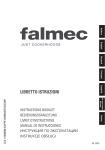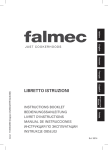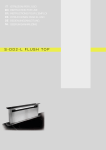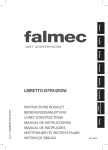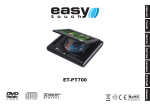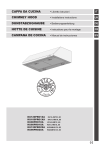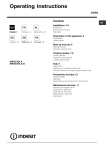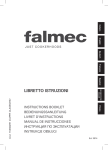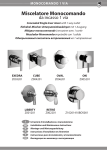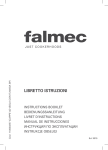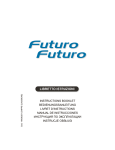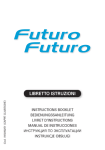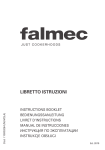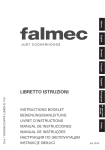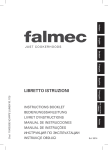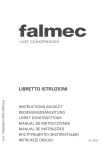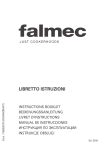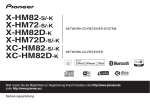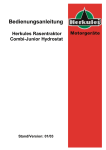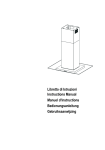Download LIBRETTO ISTRUZIONI
Transcript
Cod. 110030268 (CAPPE DIAMANTE/GLEAM) LIBRETTO ISTRUZIONI INSTRUCTIONS BOOKLET BEDIENUNGSSANLEITUNG LIVRET D’INSTRUCTIONS MANUAL DE INSTRUCCIONES àçëíêìäñàü èé ùäëèãìÄíÄñàà INSTRUKCJE OBSŁUGI Ed. 2011 Gentile Signora/Signore, congratulazioni! Lei ha acquistato una cappa di prestigio e di sicura qualità. Perché Lei possa ottenere le migliori prestazioni, Le suggeriamo di seguire con attenzione le istruzioni per l’uso e manutenzione che troverà in questo libretto; inoltre, per ordinare i filtri di ricambio al carbone attivo utilizzi l’apposito tagliando che troverà allegato alla copertina. Dear Sir/Madam, congratulations! You have purchased a prestigious range hood of guaranteed quality. For best results, we suggest that you carefully follow the operating and maintenance instructions provided in this booklet; in addition, to order spare charcoal filters, use the special coupon on the cover. Verehrte Kundin, verehrter Kunde Kompliment! Sie haben eine qualitativ hochwertige Dunstabzugshaube erworben. Um ihre Leistungsfähigkeit optimal nutzen zu können, sollten Sie die beiliegende Gebrauchs- und Wartungsanleitung sorgfältig durchlesen und befolgen. Für die Bestellung der ErsatzAktivkohlefilter verwenden Sie bitte den Coupon, der dem Deckblatt beiliegt. Chère Madame/Cher Monsieur, félicitations! Vous venez d’acheter une hotte haut de gamme. Pour en tirer les performances les meilleures veuillez lire avec attention le mode d’emploi et la maintenance que vous trouvez dans ce manuel ; pour commander les filtres de rechange au carbone actif veuillez vous servir du coupon annexé à la couverture. Enhorabuena Señora/Señor! Ha comprado una campana extractora de prestigio y calidad segura. Para que pueda obtener las mejores prestaciones, le sugerimos seguir con atención las instrucciones contenidas en este manual para el uso y el mantenimiento. Para pedir los filtros de recambio de carbón activo, utilice el cupón adjunto a la cubierta. Ç˚ ÔËÓ·ÎË ÔÒÚËÊÌÓ Ë ‚˚ÒÓÍÓ͇˜ÒÚ‚ÌÌÓ ‚˚ÚflÊÌÓ ÛÒÚÓÈÒÚ‚Ó. ÑÎfl ÚÓ„Ó, ˜ÚÓ·˚ ÓÌÓ ‰‡‚‡ÎÓ Ì‡ËÎÛ˜¯Ë ÁÛθڇÚ˚, ÍÓÏ̉ÛÏ ‚ÌËχÚθÌÓ ÒΉӂ‡Ú¸ ËÌÒÚÛ͈ËflÏ ÔÓ ˝ÍÒÔÎÛ‡Ú‡ˆËË Ë ÛıÓ‰Û, ÍÓÚÓ˚ ‚˚ Ì‡È‰Ú ‚ ˝ÚÓÏ ËÁ‰‡ÌËË; ÍÓÏ ÚÓ„Ó, ‰Îfl Á‡Í‡Á‡ Á‡Ô‡ÒÌ˚ı ÙËθÚÓ‚ ̇ ‡ÍÚË‚ËÓ‚‡ÌÌÓÏ Û„Î ËÒÔÓθÁÛÈÚ ÒԈˇθÌ˚È Ú‡ÎÓÌ, ÍÓÚÓ˚È ‚˚ ÏÓÊÚ Ì‡ÈÚË ÔËÍÔÎÌÌ˚Ï Í Ó·ÎÓÊÍ. Szanowni Państwo Gratulujemy! Zakupiliście prestiżowy okap kuchenny o gwarantowanej jakości. Dla uzyskania najlepszych wyników zalecamy, by starannie przestrzegać instrukcji obsługi i konserwacji zawartych w tej broszurze. Ponadto, do zamawiania zapasowych filtrów z węglem drzewnym, wykorzystywać specjalny kupon załączony na okładce. B A DIAMANTE hood: 525 mm GLEAM hood: 437 mm A C X Fig. 02 Fig. 01 L M M E H D E E D G Fig. 03 Fig. 04 1 Cappa GLEAM / GLEAM Hood - Fig. A1 ATTENZIONE: PANNELLI DI ASPIRAZIONE (A) CON FISSAGGIO TRAMITE PERNI ATTENTION: PANELS OF ASPIRATION (A) WITH FIXING THROUGH PIVOTS A A STEP 2 STEP 1 VERSIONE CON EVACUAZIONE POSTERIORE BACK OUTLET VERSION STEP 1 STEP 3 2 STEP 2 STEP 4 Cappa DIAMANTE / DIAMANTE Hood - Fig. A2 ATTENZIONE: PANNELLI DI ASPIRAZIONE (A) CON FISSAGGIO TRAMITE PERNI ATTENTION: PANELS OF ASPIRATION (A) WITH FIXING THROUGH PIVOTS A A A STEP 1 STEP 2 VERSIONE CON EVACUAZIONE POSTERIORE BACK OUTLET VERSION STEP 1 STEP 2 STEP 3 STEP 4 I A LIBRETTO ISTRUZIONI AVVERTENZE È molto importante che questo libretto istruzioni sia conservato insieme all’apparecchiatura per qualsiasi futura consultazione. Se l’apparecchio dovesse essere venduto o trasferito ad un’altra persona, assicurarsi che il libretto venga fornito assieme, in modo che il nuovo utente possa essere messo al corrente del funzionamento della cappa e delle avvertenze relative. Queste avvertenze sono state redatte per la vostra sicurezza e per quella degli altri, Vi preghiamo, dunque, di volerlo leggere attentamente prima d’installare e di utilizzare l’apparecchio. Questo apparecchio non deve essere utilizzato da bambini o persone infermi a meno che non siano adeguatamente controllate da persone responsabili che si assicurino che l’apparecchio sia utilizzato in sicurezza. I bambini devono essere controllati da persona responsabile per assicurarsi che non giochino con l’apparecchio. Il lavoro di installazione deve essere eseguito, da installatori competenti e qualificati, secondo le norme in vigore. Se il cavo di alimentazione è danneggiato, esso deve essere sostituito dal costruttore o dal suo servizio assistenza tecnica o comunque da una persona con qualifica similare, in modo da prevenire ogni rischio. Ogni eventuale modifica che si rendesse necessaria all’impianto elettrico per installare la cappa dovrà essere eseguita solo da persone competenti. È pericoloso modificare o tentare di modificare le caratteristiche di questo impianto. In caso di riparazioni o mal funzionamento dell’apparecchio, non tentare di risolvere da soli il problema. Le riparazioni effettuate da persone non competenti possono provocare danni. Per eventuali interventi rivolgersi ad un Centro Assistenza Tecnica autorizzato ad eseguire parti di ricambio. Controllare sempre che tutte le parti elettriche, (luci, aspiratore), siano spente quando l’apparecchio non viene usato. Leggere tutto il libretto istruzioni prima di effettuare operazioni sulla cappa. L’utilizzo della cappa non può essere diverso da quello di aspiratori di fumi di cottura su cucine domestiche. Qualsiasi utilizzo diverso da questo solleva il costruttore da qualsiasi responsabilità. Il peso massimo complessivo di eventuali oggetti posizionatio appesi (ove previsto) sulla cappa non deve superare 1,5 Kg. Dopo l’installazione delle cappe in acciaio inox bisogna eseguire la pulizia della stessa per rimuovere i residui di collante protettivo e le eventuali macchie di grasso o oli. Per questa operazione il costruttore raccomanda l’utilizzo delle salviette in dotazione, disponibili anche in acquisto. L’utilizzo di altre tipologie di detergenti solleva il costruttore dalla responsabilità sui danni che ne potrebbero derivare. 4 4 B CARATTERISTICHE TECNICHE I dati tecnici dell’elettrodomestico sono riportati su delle targhette, posizionate all’interno della cappa. C INSTALLAZIONE (parte riservata solo a persone qualificate per il montaggio della cappa) La distanza minima: distanza fra la parte più alta dell’apparecchiatura per la cottura e la parte più bassa della cappa da cucina. In generale, quando la cappa da cucina è posta su un’apparecchiatura a gas, questa distanza deve essere almeno 65 cm (25,6”) (vedi figura 01). Tuttavia sulla base di un’interpretazione della norma EN60335-2-31 del 11-07-2002 da parte del TC61 (sub-clause 7.12.1 meeting 15 agenda item 10.11), nel caso della cappa Diamante/Gleam, tale distanza minima tra piano cottura e parte inferiore della cappa può essere ridotta a 53 cm. Se le istruzioni del piano di cottura a gas specificano una distanza maggiore, bisogna tenerne conto. Nella versione aspirante il tubo completo di uscita dei fumi deve avere un diametro non inferire a quello del raccordo della cappa. Nei tratti orizzontali il tubo deve avere una leggera inclinazione (10% circa) verso l’alto per convogliare meglio l’aria all’esterno dell’ambiente. Ridurre al minimo le curve, verificare che i tubi abbiano una lunghezza minima indispensabile. Rispettare le norme vigenti sullo scarico dell’aria all’esterno. In caso di utilizzo contemporaneo di altre utenze (caldaie, stufe, caminetti, ecc.) alimentate a gas o con altri combustibili, provvedere ad una adeguata ventilazione del locale in cui avviene l’aspirazione dei fumi, secondo le norme vigenti. Istruzioni di montaggio: vedi sez. “O” del presente manuale. D ALLACCIAMENTO ELETTRICO (parte riservata solo a persone qualificate per l’allacciamento) ATTENZIONE! Prima di effettuare qualsiasi operazione all’interno della cappa scollegare l’apparecchio dalla rete elettrica. Assicurarsi che non vengano scollegati o tagliati fili elettrici all’interno della cappa; nel caso si verifichino tali situazioni contattare il centro assistenza più vicino. Per l’allacciamento elettrico rivolgersi a personale qualificato. Il collegamento deve essere eseguito in conformità con le disposizioni di legge in vigore. Controllare che la valvola limitatrice e l’impianto elettrico possano sopportare il carico dell’apparecchio (vedere targhetta caratteristiche tecniche al punto B). Alcuni tipi di apparecchi possono essere dotati di cavo senza spina; in questo caso, la spina da utilizzare deve essere dei tipo “normalizzato” tenendo conto che: - il filo giallo-verde deve essere utilizzato per la messa a terra, - il filo blu deve essere utilizzato per il neutro, 5 - il filo marrone deve essere utilizzato per la fase, il cavo non deve entrare in contatto con parti calde aventi temperature superiori a 70 °C. - montare sul cavo di alimentazione una spina adatta al carico e collegarla ad una adeguata spina di sicurezza. Se un apparecchio fisso non è provvisto di cavo di alimentazione e di spina, o di altro dispositivo che assicuri la disconnessione dalla rete, con una distanza di apertura dei contatti che consenta la disconnessione completa nelle condizioni della categoria di sovratensione III, le istruzioni devono indicare che tali dispositivi di disconnessione devono essere previsti nella rete di alimentazione conformemente alle regole di installazione. Il cavo di terra giallo/verde non deve essere interrotto dall’interruttore. Prima di collegare l’apparecchio alla rete elettrica, controllare che: - la tensione d’alimentazione corrisponda a quella indicata dalla targhetta caratteristiche tecniche. - la presa di terra sia corretta e funzionale. - l’impianto di alimentazione sia munito di efficace collegamento di terra secondo le norme vigenti. - la presa o l’interruttore omnipolare usati siano facilmente raggiungibili con l’apparecchiatura installata. La casa costruttrice declina ogni responsabilità nel caso le norme di sicurezza non vengano rispettate. E CAPPA DI VERSIONE AD EVACUAZIONE ESTERNA (aspirante) In questa versione i fumi e i vapori della cucina vengono convogliati verso l’esterno attraverso un tubo di scarico. Il convogliatore di scarico che sporge sulla parte superiore della cappa deve essere collegato con un tubo che conduce i fumi e i vapori in una uscita esterna. In questa versione vanno tolti i filtri al carbone attivo se esistenti; per l’estrazione vedere istruzioni al punto F. Quando la cappa da cucina viene utilizzata contemporaneamente ad altri apparecchi che impiegano gas o altri combustibili, il locale deve disporre di sufficiente ventilazione secondo le norme vigenti. Deviazione per la Germania: Quando la cappa da cucina e apparecchi alimentati con energia diversa da quella elettrica sono in funzione simultaneamente, la pressione negativa nel locale non deve superare i 4 Pa (4 x 10-5 bar). F CAPPA DI VERSIONE A RICICLO INTERNO (filtrante) In questa versione l’aria passa attraverso i filtri di carbone attivo per essere purificata e viene riciclata nell’ambiente cucina. Controllare che i filtri al carbone attivo siano montati sul motore, in caso negativo applicarli come indicato nelle istruzioni al punto H. 6 Se la cappa viene predisposta in versione filtrante rimuovere la valvola di non ritorno montata sul raccordo di uscita del motore. Per il miglior rendimento si consiglia di utilizzare la terza velocità in presenza di forti odori e vapori, la seconda velocità nelle condizioni normali, la prima velocità per mantenere l’aria pulita con bassi consumi di energia elettrica. Si consiglia di mettere in funzione la cappa quando si inizia a cuocere e manteneria in funzione fino alla scomparsa degli odori. G FUNZIONAMENTO 1. PULSANTIERA ELETTRONICA Pulsante luce • ON: luce accesa (pulsante illuminato); • OFF: luce spenta; Pulsante Premendo il tasto si riduce la velocità del motore. La velocità 1, 2 e 3 è visualizzata dal n° di led accesi escluso led luce e timer. Pulsante + Premendo il tasto si incrementa la velocità del motore. La velocità 1, 2 e 3 è visualizzata dal n° di led accesi escluso led luce e timer. (Nella versione a 4 velocità il tasto + presenta una luce intermittente. La 4° velocità o intensiva è temporizzata e dopo circa 15 minuti il motore passa automaticamente in 3° velocità). Pulsante modalità Funzione: accensione e spegnimento motore cappa. La funzione velocità desiderata permette di avviare il motore con l’ultima velocità selezionata prima del precedente spegnimento. Optional: versione con radiocomando (disponibile solo su alcune versioni). AVVERTENZE (versione con radiocomando): Posizionare l’apparecchio lontano da sorgenti di onde elettromagnetiche che potrebbero interferire con l’elettronica della cappa Distanza massima di funzionamento 5 metri. Tale distanza può variare in difetto in funzione delle interferenze elettromagnetiche di altri apparecchi. Pulsante luce del telecomando: on/off luce. Pulsante – e + decremento/incremento velocità (per avviare il motore premere indifferentemente tasto + o in tasto -. Pulsante timer: vedi istruzione sottostante. Pulsante timer e saturazione filtri • Questa funzione permette lo spegnimento automatico della cappa dopo 15 minuti di funzionamento alla velocità precedentemente impostata (pulsante con luce intermittente). • Dopo circa 30 ore di funzionamento il pulsante propone il lavaggio dei filtri metallici (pulsante illuminato di rosso). Per disattivare l’allarme premere il pulsante timer per qualche secondo fino allo spegnimento della luce rossa. Successivamente spegnere la cappa e riaccenderla per verificare l’annullamento dell’allarme. 7 H FILTRI ISTRUZIONI PER L’ESTRAZIONE E LA SOSTITUZIONE 1. FILTRI METALLICI Per accedere ai filtri metallici rimuovere i tre pannelli frontali (vedi fig. A1 e A2). Per togliere i filtri metallici antigrasso agire sulla maniglia. 2. FILTRI AL CARBONE ATTIVO Per la sostituzione dei filtri al carbone attivo si proceda come segue: togliere i filtri metallici come indicato sopra. A questo punto si accede facilmente ai due filtri che sono agganciati sul lato dx e sx del convogliatore. Per il montaggio/sostituzione vedi figura. Nel caso di cappa con camera motore il filtro è posizionato nella parte inferiore della camera stessa. Per il montaggio/sostituzione vedi figura. Per ordinare i nuovi filtri carbone rivolgersi al distributore/rivenditore. SOLO PER ITALIA: Scaricare l’apposito modulo ordine filtro sul sito: www. falmec.com (accedere sul menù a tendina assistenza). I ILLUMINAZIONE MONTAGGIO E SOSTITUZIONE LAMPADA FLUORESCENTE (parte riservata solo a personale qualificato) Sostituzione del tubo fluorescente: a) Scollegare l’apparecchio dalla rete di alimentazione; b) Rimuovere i pannelli in acciaio e i filtri metallici (vedi punto H1). Svitare i 2+2 perni zigrinati di fissaggio sei supporti neon in acciaio. c) Togliere il tubo fluorescente ruotandolo di 90° e sostituirlo con uno di analoghe caratteristiche (Tubo T5 da 13W); d) Ripetere in senso inverso le operazioni del punto b. e) Ricollegare l’apparecchio alla rete di alimentazione. 8 L MANUTENZIONE E PULIZIA Una costante manutenzione garantisce un buon funzionamento ed un buon rendimento nel tempo. Particolari attenzioni vanno rivolte ai filtri metallici antigrasso ed ai filtri al carbone attivo, infatti la pulizia frequente dei filtri e dei loro supporti garantisce che sulla cappa non si accumulino grassi che sono pericolosi per la facilità di incendio. 1. FILTRI ANTIGRASSO METALLICI Hanno la funzione di trattenere le particelle grasse in sospensione, pertanto si consiglia di lavarli ogni mese in acqua calda e detersivo evitando di piegarli. Attendere che siano ben asciutti prima di rimontarli. Per lo smontaggio e montaggio vedi istruzioni al punto H1. Si raccomanda costante frequenza nell’operazione. 2. FILTRI AL CARBONE ATTIVO Hanno la funzione di trattenere gli odori presenti nel flusso d’aria che li attraversa. L’aria depurata per successivi passaggi attraverso i filtri viene rimessa nell’ambiente cucina. l filtri al carbone attivo non possono essere lavati e vanno sostituiti mediamente ogni 3-4 mesi (dipende poi dall’uso). Per la sostituzione dei filtri al carbone attivo seguire le istruzioni come al punto H2. 3. PULIZIA ESTERNA Si raccomanda di pulire le superfici esterne delle cappe almeno ogni 15 giorni per evitare che le sostanze oleose o grasse possano intaccare le superfici in acciaio. La pulizia della cappa va eseguita usando un panno umido con detersivo liquido neutro o con alcool denaturato. Nel caso di materiale con trattamento antimpronta (Fasteel) eseguire la pulizia solo con acqua e sapone neutro utilizzando un panno morbido avendo cura di risciacquare e asciugare accuratamente. Non si devono utilizzare prodotti contenenti sostanza abrasive, panni con superfici ruvide o panni comunemente in commercio per la pulizia dell’acciaio. L’utilizzo di sostanze abrasive e panni ruvidi danneggerà irreparabilmente il trattamento superficiale dell’acciaio. Conseguenza diretta del non rispetto di tali avvertenze sarà il deterioramento irreversibile della superficie dell’acciaio. Tali avvertenze dovranno essere conservate insieme al libretto istruzioni della cappa. Il produttore declina ogni responsabilità qualora non vengano rispettate tali istruzioni. 4. PULIZIA INTERNA É vietata la pulizia di parti elettriche o parti relative al motore all’interno della cappa, con liquidi o solventi; Non usare prodotti contenenti abrasivi. Effettuare tutte queste operazioni scollegando preventivamente l’apparecchio dalla rete elettrica. M SICUREZZA AVVERTENZE L’impianto elettrico è munito di collegamento a terra secondo le norme di sicurezza internazionali; è inoltre conforme alle normative Europee sull’antidisturbo radio. Non collegare l’apparecchio a condotti di scarico dei fumi prodotti dalla com9 bustione (caldaie, caminetti,ecc). Verificare che la tensione di rete corrisponda a quella riportata dalla targhetta posta all’interno della cappa. Non fare cotture a fiamma “libera” sotto la cappa. Controllare le friggitrici durante l’uso: I’olio surriscaldato potrebbe infiammarsi. - Assicurarsi che vi sia una adeguata ventilazione nella stanza se la cappa è utilizzata con altri apparecchi che utilizzano combustibili come gas o altro. - Non accendere fiamme libere sotto la cappa. - Non collegare l’apparecchio a condotti di scarico dei fumi prodotti dalla combustione (caldaie, caminetti, ecc). - Assicurarsi che tutte le normative vigenti sullo scarico dell’aria all’esterno del locale siano rispettate prima dell’utilizzo della cappa. Prima di procedere a qualsiasi operazione di pulizia o di manutenzione, disinserire l’apparecchio togliendo la spina o agendo sull’interruttore generale. La casa costruttrice declina ogni responsabilità per eventuali danni che possano, direttamente o indirettamente, essere causati a persone, cose ed animali domestici in conseguenza alla mancanza di tutte le prescrizioni indicate nell’apposito libretto istruzioni e concernenti, specialmente, le avvertenze in tema di installazione, uso e manutenzione dell’apparecchio. N GARANZIA La sua nuova apparecchiatura è coperta da garanzia. Le condizioni di garanzia sono riportate per esteso sull’ultima pagina di copertina di questo libretto. La casa costruttrice non risponde delle possibili inesattezze, imputabili ad errori di stampa o di trascrizione, contenute nel presente libretto. Si riserva di apportare ai propri prodotti quelle modifiche che ritenesse necessarie o utili, anche nell’interesse dell’utenza, senza pregiudicare le caratteristiche essenziali di funzionalità e di sicurezza. O ISTRUZIONI MONTAGGIO CAPPA Fase 1 - Appoggiare alla parete la barra di sostegno (A-fig. O1), ad un’altezza dal piano cottura determinata dalla somma delle quote: X+525 mm. Dove X può variare da 530 a 650 mm. - Nel caso di evacuazione posteriore vedi fig. A. - Controllare con una bolla di livello l’allineamento orizzontale e segnare alle estremità della barra n° 2 punti di foratura. - Forare, inserire n° 2 tasselli ad espansione ø 8mm e fissare la barra con le relative viti. Fase 2 - Agganciare la cappa alla barra di sostegno (fig. O2). - Regolare l’allineamento della cappa tramite le viti delle attaccaglie (fig. O2). La vite superiore (B) regola la distanza dalla parete, quella inferiore (C) lo scorrimento verticale. Fase 3 - Per evitare lo sganciamento della cappa dovuto ad una pressione sottostante, fissare la cappa alla parete con i tasselli ad espansione e relative viti utlilizzando gli appositi fori (fig. O3) ricavati sulla schiena della cappa o la 10 eventuale staffetta sul coperchio. Inserire sul raccordo tubo (D) il tubo (E) fig. 03. Nel caso di montaggio con scarico posteriore vedi fig. A. Fase 4 (optional) - Posizionare il camino (G) e la prolunga (H) come indicato in fig. O4. - Infilare nell’elemento (G) la prolunga (H), facendola scorrere fino a raggiungere l’altezza desiderata. - Trovata la posizione ottimale, appoggiare alla parete la staffa (L), controllare con una bolla di livello l’allineamento orizzontale e segnare alle estremità n°2 punti di foratura. - Forare, inserire n° 2 tasselli ad espansione ø 4mm e fissare la staffa (L) con le relative viti. - Avvitare con le viti (M) la prolunga (H) alla staffa (L). 11 GB A INSTRUCTIONS BOOKLET WARNINGS This instruction booklet must be kept together with the appliance for future reference. If the appliance is sold or consigned to other parties, check that the booklet is supplied with it, to ensure that the new user has the correct information on the operation of the range hood and is aware of the warnings. These warnings have been provided for the your safety and the safety of others. As a result, please read them carefully before installing and operating the appliance. This appliance is not intended for use by young children or infirm persons unless they have been adequately supervised by a responsible person to ensure that they can use the appliance safely. Young children should be supervised to ensure they do not play with the appliance. The appliance must be installed by qualified personnel, in accordance with the standards in force. If the supply cord is damaged, it must be re-placed by the manufacturer, its service agent or similarly qualified persons in order to avoid a hazard. Any modifications that may be required to the electrical system for the installation of the range hood must only be made by qualified electricians. It is dangerous to modify or attempt to modify the characteristics of this system. In the event of malfunctions or if repairs are required to the appliance, do not attempt to solve the problems directly. Repairs performed by unqualified persons may cause damage. For all repair and other work on the appliance, contact an authorised service/spare parts centre. Always check that all the electrical parts (lights, exhaust device), are off when the appliance is not being used. Read the entire instruction booklet before performing any operations on the range hood. The range hood must only be used for the exhaust of cooking fumes in home kitchens. The manufacturer disclaims all liability for any other use of the appliance. The maximum weight of any object placed above the hood, or hung to it (if possible) must not exceed 1,5 kilos. After installing the stainless steel hood, clean it in order to remove any residue of the protective glue, and stains of grease or oil. The manufacturer recommends its cleaning cloth available for purchase. The manufacturer accepts no liability in case of damage caused by the use of different detergent types. B TECHNICAL SPECIFICATIONS The technical data pertaining to the electric appliance The technical specifications of the appliance are shown on the rating plates located inside the range hood. 12 C INSTALLATION (Section reserved for qualified installers of the range hood) Minimum distance between the higher part of the cooker and the lower part of the hood: usually, when a hood is fitted on a gas appliance, this distance must be at least 65 cm.(25,6”) see Fig. 01. However, on the basis of EN60335-2-31 of 11-07-2002 from TC61 (sub-clause 7.12.1 meeting 15 agenda item 10.11), in the case of a Diamante/Gleam hood the distance can be reduced to 53 cm, but any instructions to the contrary for the cooker must be taken into consideration. In the extractor version the whole pipe must have a diameter similar or bigger than the one linked to the hood. In the horizontal parts the pipe must be inclined slightly (about 10%) to the top in order to better channel the fumes outside. Avoid using angled pipes, make sure that the pipes are at least of the minimum length. Comply with the current regulations on air discharge into the atmosphere. If a boiler, stove, fireplace, etc. that uses gas or other fuels is being used at the same time, make sure the room where the fumes are extracted is well ventilated, in compliance with the current regulations. Mounting instruction: see section “O” of the booklet. D ELECTRICAL CONNECTIONS (Section reserved for qualified installers) WARNING! Before doing any work inside the range hood, disconnect the appliance from the mains power supply. Check that the wires inside the range hood are not disconnected or cut; if this is the case, contact your nearest service centre. The electrical connections must be performed by qualified personnel. The connections must be performed in compliance with the legal standards in force. Check that the relief valve and the electrical system are able to support the load of the appliance (see the technical specifications in point B). Some types of appliance are supplied with a cable without plug; in this case, “standardised” plugs must be used, keeping in mind that: - the yellow-green wire must be used for the earth, - the blue wire must be used for the neutral, - the brown wire must be used for the phase; the cable must not come into contact with hot parts (over 70 °C). - fit a plug that is suitable for the load to the power cable, and connect it to a suitable power outlet. For appliances that come supplied with cable and plug please ensure they are plugged into a circuit suitable for this appliance. Please refer to a qualifed person. (See technical specifications in point B). The manufacturer declines all liability if the safety standards are not observed. 13 13 E RANGE HOOD WITH OUTSIDE DISCHARGE (exhaust) In this version, the fumes and steam from the kitchen are conveyed outside through an exhaust duct. The exhaust conveyor that protrudes from the upper part of the range hood must be connected to a duct that carries the fumes and steam outside. In this version, the charcoal filters, if fitted, should be removed; to do this, see the instructions in point F. There must be adequate ventilation of the room when the range hood is used at the same time as appliances burning gas or other fuels, according to the standard. Deviation for Germany: When the range hood and appliances supplied with energy other than electricity are simultaneously in operation, the negative pressure in the room must not exceed 4 Pa (4x10 E-5 bar). F RECIRCULATING RANGE HOOD (with filter) In this version, the air passes through charcoal filters for purification, and is then recirculated back into the kitchen. Check that the charcoal filters are fitted to the motor, and if not, install them as described in the instructions in point H. If the hood is of filtering type, remove the non-return valve fitted at the motor’s outlet. For maximum efficiency, the third speed should be used when there are strong odours or a lot of steam, the second speed in normal conditions, and the first speed for keeping the air clean with minimum energy consumption. The range hood should be switched on when starting to cook, and left on until the odours disappear. G OPERATION 1. ELECTRONIC CONTROL PANEL Light pushbutton • ON: light on (the pushbutton is lit); • OFF: light off; Pushbutton Press to reduce motor speed Speed 1, 2 and 3 are indicated by the number of LEDs that light up (excluding the light and the timer LEDs). Pushbutton + Press to increase motor speed Speed 1, 2 and 3 are indicated by the number of LEDs that light up (excluding the light and the timer LEDs). 14 (In the 4-speed version the pushbutton + blinks. The fourth speed remains on for a set duration of time. After 15 minutes the motor returns to the third speed). Mode pushbutton Function: it turns hood motor on and off. The function “desired speed” enables to start the motor at the speed that was selected before the hood was last turned off. Optional: version with remote control (some versions only). WARNING: Install the hood away from sources of electromagnetic waves, as these could affect the correct operation of the electronic system. Maximum operating distance: 5 metres. The maximum operating distance could be less than 5 metres in case of electromagnetic interference by other equipment. Light pushbutton on remote control: light on/off. – and + pushbutton: increase/decrease speed (to start the motor press either the + or the – pushbutton). Timer pushbutton: see instructions below. Timer and ‘filter clogged’ alarm pushbutton • This function allows the automatic turning off of the hood after running for 15 minutes at the speed previously set (the pushbutton shows a flickering light). • After about 30 hours of running the pushbutton indicates the need for washing the metal filters (the pushbutton shows a solid red light). To disable the alarm press the pushbutton for a few seconds until the red light turns off. Then turn the hood off and on again to check that the alarm has disappeared. H FILTERS REMOVING AND REPLACING’S INSTRUCTIONS 1. METAL FILTERS To reach the metal filters one must remove the three frontal panels (see fig A1 and A2). To remove the metal filters use the handle. 2. CHARCOAL FILTERS To replace the charcoal filters, proceed as follows: remove the metal filters as described above. The two filters located at the ends of the motor can now be easily accessed. To install the new filters see picture. In case of hood with the motor box the filter is located on the botton part of the motor box. To install the new filters see picture. To order new charcoal filters contact the distributor/retailer. VALID ONLY FOR ITALY: download the appropriate order form from: www. falmec.com (access the assistance drop-down menu). I LIGHTING ASSEMBLY AND REPLACEMENT FLUORESCENT TUBE (Section reserved for qualified installers) Fluorescent tube replacement: a) Disconnect the appliance from the mains. b) Remove the steel panel and the metal filters (see H 1). Undo the 2+2 knurled fixing studs in the steel support. c) Remove the neon tube by rotating it by 90° and replace it with an identical one (13W tube T5). d) Repeat point B in reverse. e) Reconnect the appliance to the mains L MAINTENANCE AND CLEANING Constant maintenance ensures the correct operation and efficiency of the appliance over time. Special attention should be paid to the metal grease-trapping filters and the charcoal filters. Frequent cleaning of the filters and their supports will ensure that fats and grease do not accumulate on the range hood, with the consequent risk of fire. 1. METAL GREASE-TRAPPING FILTERS These trap the fat and grease particles suspended in the air, and therefore should be washed every month in hot water and detergent, without bending them. Wait until they are completely dry before repositioning them. To remove and replace these filters, see the instructions in point H1. This operation should be performed at regular intervals. 2. CHARCOAL FILTERS These trap the odours present in the stream of air that passes through them. The air is purified by passing a number of times through the filters and being recirculated into the kitchen. The charcoal filters cannot be cleaned, and should be replaced on average every 3-4 months (according to use). To replace the charcoal filters, see the instructions in point H2. 16 3. CLEANING THE OUTSIDE OF THE APPLIANCE It is advised to clean the external hood surfaces at least every 15 days in order to avoid that oily or greasy substances affect the steel surfaces. The ouside of the range hhod should be cleaned using a damp cloth and neutral liquid detergent or denatured alcohol. In case of fingerprint-less finish (fasteel) clean only with water and neutral soap using clean with a soft cloth, rinse and wipe dry thoroughly. Do not use products that contain abrasive substances, rough cloths or cloths specifically designed for cleaning steel. Using abrasive substances or rough cloths will inevitably damage the finish of steel. The steel surface will be irrevocably damaged if the instructions above are not complied with. Keep these instructions together with the instructions for use of your hood. The manufacturer accepts no liability for any damage caused by non-compliance with the instructions above. 4. CLEANING THE INSIDE OF THE APPLIANCE The electrical parts or parts of the motor assembly inside the range hood must not be cleaned using liquids or solvents. Do not use abrasive products. All the above operations must be performed after having disconnected the appliance from the mains power supply. M SAFETY WARNINGS The electrical system features an earth connection in compliance with international safety standards; furthermore, it is compliant with the European standard for electromagnetic compatibility. Do not connect the appliance to flues (from boilers, fireplaces, etc.). Make sure the mains voltage corresponds to the values on the rating plate located inside the range hood. Never cook on “open” flames under the range hood. Check deep-fryers during use: superheated oil may be flammable. - Ensure there is adequate ventilation of the room when the rangehood is used at the same time as appliances burning gas or other fuels. - Do not flambe under the rangehood - The exhaust air must not be discharged into a flue which is used for exhausting fumes from appliances burning gas or other fuels. - Ensure that all regulations concerning the discharge of exhaust air have been fulfilled before you use the appliance. Before performing any cleaning or maintenance operations, disconnect the appliance by unplugging it or using the main switch. The manufacturer disclaims all liability for any damage that may be directly or indirectly caused to people, things and animals due to the failure to follow all the instructions provided in this booklet and above all the warnings relating to the installation, operation and maintenance of the appliance. N WARRANTY The new equipment is covered by warranty. The warranty conditions are provided by the distributor. 17 The manufacturer is not liable for any inaccuracies in this booklet resulting from printing or transcription errors. The manufacturer reserves the right to modify its products as it considers necessary or in the interests of the user, without compromising their essential safety and operating characteristics. O MOUNTING INSTRUCTIONS, RANGE HOODS Phase 1 - Lean the propping bar against the wall A (fig. 01), away from the cooking surface by a height calculated by the total sum of the numbers: X+525 mm. (where X can vary between 530 and 650 mm). - Should there be a rear flue see fig. A. - Check with a spirit level the horizontal alignment and mark two fixing points at the ends of the bar. - Drill a hole, insert 2x8 mm wall anchors and fix the bar with the screw provided. Phase 2 - Hook the hood to the propping bar (fig. 02). - Check the hood’s alignment using the fixing screws.(fig. 02). The upper screw (B) set the distance from the wall, the lower (C) the vertical slide. Phase 3 To avoid any unhooking of the hood fix it to the wall with the screws and wall anchors supplied as follows: - through the holes on the back of the hood and any strap on the cover. - Insert in pipe union D pipe E (fig. 3) - Should the fixing include a rear flue see fig. A. Phase 4 (optional) - Position chimney (G) and extension (H) as shown in fig. 04. - Insert in G extension H, making it slip until the required height is reached. - When happy with the location, lean bar L against the wall, check with a spirit level the horizontal alignment and mark two fixing points at the ends of the bar. - Drill a hole, insert 2x4 mm. wall anchors and fix bar L with the screw provided. - Screw extension H to bar L Using screws M. 18 D A BEDIENUNGSANLEITUNG HINWEISE Diese Bedienungsanleitung muss unbedingt zusammen mit dem Gerät aufbewahrt werden, um in Zukunft nachgeschlagen werden zu können. Sollte das Gerät verkauft bzw. einer anderen Person übergeben werden, muss die Bedienungsanleitung unbedingt mitgeliefert werden, damit der neue Benutzer mit dem Betrieb der Dunstabzugshaube und den diesbezüglichen Hinweisen vertraut werden kann. Diese Hinweise sind für Ihre Sicherheit und die anderer Personen abgefasst worden. Daher sollten Sie die Bedienungsanleitung vor der Installation und Verwendung des Gerätes aufmerksam durchlesen. Das Gerät darf nicht von Kindern bzw. Behinderten benutzt werden, es sei denn diese werden von verantwortungsvollen Personen, die dafür Sorge tragen, dass das Gerät sicher verwendet wird, überwacht. Kinder müssen von einer von verantwortungsvollen Person überwacht werden, damit sie nicht mit dem Gerät spielen. Die Installation hat den geltenden Vorschriften gemäß von kompetenten, qualifizierten Installateuren durchgeführt zu werden. Beschädigte Speisekabel sind vom Hersteller bzw. von dessen Kundenservice bzw. von einer Person mit ähnlicher Qualifikation auszuwechseln, um Gefahren vorzubeugen. Eventuelle erforderliche Änderungen, die für die Installation der Dunstabzugshaube an der elektrischen Anlage durchgeführt werden müssen, dürfen ausschließlich von kompetenten Personen vorgenommen werden. Es ist gefährlich, die Eigenschaften dieser Anlage abzuändern bzw. versuchen abzuändern. Bei Reparaturen bzw. Betriebsstörungen des Gerätes nicht versuchen, das Problem alleine zu lösen. Die Reparaturen, die von nicht kompetenten Personen durchgeführt werden, können Schäden verursachen. Sich für eventuelle Eingriffe an einen zugelassenen Kundenservice, der über die geeigneten Ersatzteile verfügt, wenden. Wenn das Gerät nicht benutzt wird, müssen alle elektrischen Teile (Beleuchtung, Absaugvorrichtung) ausgeschaltet sein. Vor Durchführung von Arbeitsvorgängen an der Dunstabzugshaube die Bedienungsanleitung lesen. Die Dunstabzugshaube darf ausschließlich zum Absaugen des Dampfes, der beim Kochen in einer Haushaltsküche entsteht, verwendet werden. Bei anderen Einsätzen wird der Hersteller von jeder Haftung befreit. Das Gesamtgewicht von Gegenständen, die eventuell auf die Dunstabzugshaube positioniert bzw. an diese gehängt werden (falls vorgesehen), darf höchstens 1,5 Kg betragen. Nach der Installation von Edelstahlhauben muss man diese reinigen, um Schutzkleberreste und eventuelle Fett- und Ölflecken zu entfernen. Der Hersteller empfiehlt für doesen Arbeitsvorgang die Verwendung der mitgelieferten Reinigungstücher. Die Verwendung anderer Reinigungsmittel befreit den Hersteller von jeder Haftung für eventuelle auf deren Benutzung zurückzuführende Schäden. 19 B TECHNISCHE MERKMALE Die technischen Daten des Elektrogeräts sind an den Typenschildern im Innern der Dunstabzugshaube angegeben. C INSTALLIERUNG (Dieser Abschnitt ist Fachpersonal mit der für die Montage der Dunstabzugshaube erforderlichen Qualifikation vorbehalten) Der Mindestabstand: der Abstand zwischen dem höchst gelegenen Bereich der Kochstelle und dem niedrigst gelegenen Bereich der Küchenabzugshaube. Im allgemeinen gilt: wenn die Küchenabzugshaube über einem Gasherd installiert wird, dann muss dieser Abstand mindestens 65 cm (25,6”) betragen (siehe Abbildung 01). In jedem Fall kann nach einer Auslegung der EU- Vorschrift EN60335-2-31 vom 11.07.2002 von Seiten der TC61 (sub-clause 7.12.1 meeting 15 agenda item 10.11) für die Abzugshaube Diamante/Gleam dieser Mindestabstand zwischen der Kochstelle und dem unterem Bereich der Abzugshaube auf 53 cm reduziert werden. Wenn die Gebrauchsanleitung des Gaskochherds einen größeren Abstand vorschreibt, dann muss dieser eingehalten werden. In der absaugenden Ausführung darf der komplette Kamin für den Rauchluftabzug keinen kleineren Durchmesser, als die Rohrmuffe der Abzugshaube aufweisen. In den waagrechten Strecken muss das Rohr leicht nach oben geneigt (circa 10%) montiert werden, damit die Abzugsluft optimal nach außen befördert werden kann. So wenig Kurven wie möglich verwenden und überprüfen, dass die Rohre die Mindestänge einhalten. Die geltenden Vorschriften bezüglich des Luftablasses nach draußen beachten. Bei gleichzeitiger Verwendung anderer mit Gas oder anderen Brennstoffen gespeister Verbraucher (Heizkessel, Öfen, Kamine, usw...) für eine angemessene, vorschriftsmäßige Lüftung des Raumes, in dem die Rauchabsaugung erfolgt, sorgen. Montageanleitungen: siehe Abschnitt “O” der vorliegenden Bedienungsanleitung. D ELEKTRISCHER ANSCHLUSS (Dieser Abschnitt ist Fachpersonal mit der für den Stromanschluss erforderlichen Qualifikation vorbehalten) ACHTUNG! Vor jedem Eingriff im Innern der Haube muss das Gerät vom Stromnetz getrennt werden. Sicherstellen, dass die Stromkabel im Innern der Dunstabzugshaube nicht abgeklemmt oder durchgeschnitten werden; sollte dies dennoch vorkommen, den nächst gelegenen Kundendienst kontaktieren. Der Anschluss muss unter Befolgung der gültigen Rechtsvorschriften erfolgen. Sicherstellen, dass das Reduzierventil und die Elektroanlage der Geräteleistung entsprechen (siehe technische Spezifikationen in Punkt B). Einige Gerätetypen können mit einem Kabel ohne Stecker ausgestattet sein, in diesem Fall ist ein „genormter“ Stecker zu verwenden, wobei folgendes zu beachten ist: - Der gelb/grüne Draht ist für die Erdung zu benutzen; - der blaue Draht ist für den Nullleiter, und 20 - der braune Draht für die Phase bestimmt. Das Kabel darf auf keinen Fall mit heißen Teilen in Berührung kommen (über 70 °C). - Am Netzkabel einen der Geräteleistung entsprechenden Stecker anbringen und diesen in eine Sicherheits- Steckdose stecken. Bei Geräten, die mit Kabel und Stecker ausgestattet geliefert werden, muss man sicherstellen, dass sie mit einem geeigneten Kreislauf verbunden werden. Sich an eine qualifizierte Person wenden (siehe technische Spezifikationen in Punkt B). Die Herstellerfirma ist nicht haftbar, wenn die Unfallverhütungsvorschriften nicht eingehalten werden. E HAUBE MIT ABLUFTBETRIEB (absaugend) Bei dieser Ausführung wird der während des Kochens entstehende Dampf durch ein Abzugsrohr nach außen abgeführt. Der sich oberhalb der Haube befindliche Rauchzug ist an ein Abzugsrohr anzuschließen, über das Rauch und Dampf zu einem Auslass ins Freie geleitet werden. Bei dieser Ausführung sind eventuell vorhandene Aktivkohlefilter wie in Punkt F beschrieben zu entfernen. Wenn die Dunstabzugshaube gleichzeitig mit anderen Geräten benutzt wird, die mit Gas oder anderen Brennstoffen betrieben werden, muss eine ausreichende Belüftung des Raums gesorgt werden. Germany (Feuerungsverordnung vom 31-01-1986 und DVGW-TRGI 1986, Amtsblatt G 600): Bei gleichzeitigem Betrieb der Dunstabzugshau-be im Abluftbetrieb und Feuerstätten darf im Aufstellraum der Feuerstätte der Unterdruck nicht größer als 4 Pa (4 x 10-5 bar) sein. F HAUBE MIT UMLUFTBETRIEB (filtrierend) Bei dieser Ausführung strömt die Luft durch Aktivkohlefilter, wo sie gefiltert und erneut an den Raum abgegeben wird. Sicherstellen, dass die Aktivkohlefilter am Motor installiert sind, andernfalls müssen sie wie unter Punkt H beschrieben installiert werden. Bei Dunstabzugshauben im Umluftbetrieb empfehlen wir die Rückstauklappe, die am Ausgangsverbindungsstück des Motors montiert ist, zu entfernen. Für optimale Leistung ist es ratsam, bei starker Geruch- und Dampfbildung die dritte Drehzahlstufe, und unter normalen Bedingungen die zweite Stufe einzustellen. Die erste Drehzahlstufe dient dazu, die Luft bei geringem Energieverbrauch sauber zu halten. Die Haube sollte bei Kochbeginn eingeschaltet, und erst wieder ausgeschaltet werden, wenn der Raum vollkommen geruchsfrei ist. 21 G ARBEITSWEISE 1. ELEKTRONISCHES BEDIENFELD Lichtknopf • ON: Licht eingeschaltet (Druckknopf beleuchtet); • OFF: Licht ausgeschaltet. Druckknopf Bei Betätigung dieses Druckknopfes wird die Motorgeschwindigkeit reduziert. Die Geschwindigkeit 1,2 und 3 wird von der eingeschalteten Ledanzahl ausschließlich Licht- und Schaltuhrled angezeigt. Druckknopf + Bei Betätigung dieses Druckknopfes wird die Motorgeschwindigkeit gesteigert. Die Geschwindigkeit 1,2 und 3 wird von der eingeschalteten Ledanzahl ausschließlich Licht- und Schaltuhrled angezeigt. (In der Ausführung mit 4 Geschwindigkeiten zeichnet sich die Taste + durch ein Blinklicht aus. Die 4. Geschwindigkeit (Intensivgeschwindigkeit) ist zeitgesteuert und nach ca. 15 Minuten geht der Motor automatisch zur 3. Geschwindigkeit über). Modalität- Druckknopf Funktion: Ein- und Ausschaltung des Abzugshaubenmotors. Die Funktion “gewünschte Geschwindigkeit” gestattet die Einschaltung des Motors bei der Geschwindigkeit, die vor der letzten Ausschaltung gewählt worden war. Option: Ausführung mit Fernbedienung (nur für einige Ausführungen erhältlich). HIN WEISE: Das Gerät nicht in der Nähe von elektromagnetischen Wärmequellen positionieren, da diese die Funktion der Elektronik der Dunstabzugshaube beeinträchtigen könnten. Maximaler Betriebsabstand 5 Meter. Dieser Abstand kann bei elektromagnetischen Interferenzen anderer Geräte kürzer sein. Lichtknopf der Fernbedienung: On/Off Licht. Druckknopf – und + Reduzierung/Steigerung der Geschwindigkeit (zur Motoreinschaltung ist es gleichgültig, ob man auf die Taste + oder - drückt. Schaltuhrknopf: siehe nachstehende Anleitungen. Druckknopf Schaltuhr und Filterverstopfung • Diese Funktion gestattet die automatische Ausschaltung der Dunstabzugshaube nach einem Betrieb von 15 Minuten bei der zuvor eingestellten Geschwindigkeit (Druckknopf mit Blinklicht). • Nach 30 Betriebsstunden zeigt der Druckknopf an, daß eine Spülung der Metallfilter erforderlich ist (Druckknopf rot beleuchtet). Anschließend die Dunstabzugshaube ausschalten undwieder einschalten, um zu prüfen, ob der Alarm aufgehoben wurde. 22 H ANLEITUNGEN FÜR AUSBAU UND ERSATZ 1. METALLFILTER Um an die Metallfilter zu gelangen die drei vorne an der Abzugshaube Paneelen entfernen (siehe Abbildung A1 und A2). Für das Entfernen der Fettfilter aus Metall den Griff betätigen. 2. AKTIVKOHLEFILTER Um die Aktivkohlefilter auszuwechseln, wie folgt vorgehen: die Metallfilter, wie zuvor erklärt, entfernen. Auf diese Weise kann man die zwei Filter, die an der rechten und linken Seite des Leitblechs befestigt sind, leicht erreichen. Für die Montage/das Auswechseln siehe Abb. Im Falle von Dunstabzugshauben mit Motorkammer befindet sich der Filter im unteren Kammerteil. Für die Montage/das Auswechseln siehe Abb. Zur Bestellung neuer Karbonfilter bitte an die Vertragshandlung/Vertriebsunternehmen. NUR FÜR ITALIEN: Entsprechendes Formular von der Internetseite: www. falmec.com herunterladen (Zugriff über Pull-down-Menü). I BELEUCHTUNG MONTAGE UND ERSATZ FLUORESZIERENDE LAMPE (nur Fachpersonal gewidmetes Kapitel) Austausch der Leuchtröhre: a) Das Gerät vom Stromnetz trennen; b) Die Stahlpaneelen und die Metallfilter entfernen (siehe Punkt H1). Die 2+2 gerändelten Befestigungsstifte und die sechs Neonhalter aus Edelstahl abschrauben. c) Die Neonröhre mit einer 90° Umdrehung entfernen und mit einer neuen 23 des gleichen Typs austauschen (13 W- Neonröhre T5); d) Die in Punkt b beschriebenen Vorgänge in umgedrehter Reihenfolge wiederholen. e) Das Gerät wieder an das Stromnetz anschließen. L WARTUNG UND REINIGUNG Nur durch eine konstante Wartung ist ein einwandfreier Betrieb und eine lange Lebensdauer der Dunstabzugshaube gewährleistet. Besondere Aufmerksamkeit ist den Metall-Fettfiltern und den Aktivkohlefiltern zu schenken. Eine häufige Reinigung der Filter und deren Halter gewährleistet, dass sich an der Dunstabzugshaube keine feuergefährlichen Fettansammlungen bilden. 1. METALL-FETTFILTER Diese Filter haben die Aufgabe, die schwebenden Fettteilchen zurückzuhalten, sie sollten daher jeden Monat mit warmem Wasser. Gereinigt werden, wobei darauf zu achten ist, dass sie nicht geknickt werden. Für den Ausund Einbau wird auf die Anleitungen unter Punkt H1 verwiesen. Die Reinigung muss unbedingt regelmäßig durchgeführt werden. 2. AKTIVKOHLEFILTER Diese Filter haben die Aufgabe, die in der Luft, die sie durchströmt, enthaltenen Gerüche zurückzuhalten. Die durch mehrmaliges Durchströmen der Filter gereinigte Luft wird wieder in die Küche zurückgeführt. Die Aktivkohlefilter können nicht gewaschen werden und müssen durchschnittlich alle 3-4 Monate ersetzt werden (die Häufigkeit hängt vom Gebrauch ab). Für den Ersatz der Aktivkohlefilter wird auf die Anleitungen unter Punkt F verwiesen. 3. AUSSENREINIGUNG Wir empfehlen, die äußeren Oberflächen der Hauben mindestens alle 15 Tage zu reinigen, um zu vermeiden, dass die öligen oder fettigen Substanzen die Oberflächen aus Stahl angreifen. Die Reinigung der Dunstabzugshaube wird mit einem feuchten Schwamm und einem neutralen Flüssigreiniger bzw. denaturiertem Alkohol durchgeführt. Bei Material, dass einer Fingerabdruckschutzbehandlung (Fasteel) unterzogen wurde, die Reinigung nur mit Wasser und einer neutralen Seife vornehmen; hierfür ein weiches Tuch verwenden, gründlich abspülen und trocknen. Es dürfen keine Produkte, die Scheuermittel enthalten, Tücher mit rauher Oberfläche bzw. handelsübliche Tücher für die Stahlreinigung verwendet werden. Die Verwendung von Scheuermitteln und rauhen Tüchern wird die Oberflächenbehandlung des Stahls für immer beschädigen. Bei Nichtbeachtung dieser Hinweise wird es zu einer nicht mehr zu beseitigenden Beschädigung der Stahlfläche kommen. Die vorliegenden Hinweise müssen zusammen mit der Bedienungsanleitung der Dunstabzugshaube aufbewahrt werden. Der Hersteller lehnt bei Nichtbeachtung dieser Anweisungen jede Haftung ab. 4. REINIGUNG DER INNENFLÄCHE Die elektrischen Teile oder Teile des Motors im Innern der Dunstabzugshaube dürfen nicht mit Flüssigkeiten oder Lösemittel gereinigt werden. Keine Schleifmittel benutzen. Vor der Reinigung muss das Gerät vom Stromnetz getrennt werden. 24 M SICHERHEITSBESTIMMUNGEN Die elektrische Anlage ist mit einer Erdung ausgestattet, die den internationalen Sicherheitsvorschriften entspricht; sie erfüllt außerdem die europäischen Entstörungsvorschriften. Das Gerät auf keinen Fall an die Ablassleitungen von Rauch, das durch Verbrennung entsteht (Heizkessel, Kamine, usw...), anschließen. Sich vergewissern, dass die Netzspannung mit den im Inneren der Dunstabzugshaube angegebenen Daten übereinstimmt. Auf keinen Fall unter der Dunstabzugshaube auf “offenem Feuer” kochen. Die Friteusen während der Benutzung kontrollieren: das überhitzte Öl könnte sich entzünden. Für eine ausreichende Lüftung im Raum sorgen, wenn die Dunstabzugshaube zusammen mit anderen Geräten, die mit Brennstoffen und ähnlichen Stoffen arbeiten, verwendet wird. - Kein offenes Feuer unter der Haube anzünden. - Das Gerät auf keinen Fall an die Ablassleitungen von Rauch, das durch Verbrennung entsteht (Heizkessel, Kamine, usw...), anschließen. - Sich vergewissern, dass alle gelten Vorschriften bezüglich der Luftablasses außerhalb des Raumes erfüllt werden, bevor man die Dunstabzugshaube benutzt. Vor Durchführung von Reinigungs- oder Wartungsarbeiten muss man die Stromversorgung unterbrechen, indem man den Stecker zieht bzw. den Hauptschalter betätigt. Der Hersteller lehnt jede Haftung für eventuelle direkte oder indirekte Schäden an Personen, Gegenständen und Haustieren ab, die auf die Nichteinhaltung der in der vorliegenden Bedienungsanleitung enthaltenen Vorschriften zurückzuführen sind und insbesondere die Installation, Bedienung und Wartung des Gerätes betreffen. N GARANTIE Was die garantie betrifft, wenden sie sich am austräger. Die Herstellerfirma haftet nicht für mögliche Ungenauigkeiten infolge Druckoder Schreibfehler in diesem Anleitungsheft. Sie behält sich außerdem das Recht vor, an ihren Produkten sämtliche Änderungen vorzunehmen, die sie auch im Interesse des Benutzers für erforderlich oder nützlich erachtet, ohne die wesentlichen Merkmale in Bezug auf Funktionalität und Sicherheit zu beeinträchtigen. O MONTAGEANLEITUNG DUNSTABZUGSHAUBE Phase 1 - Die Haltestange (A-Abbildung O1) auf der Höhe der Kochstelle, die sich aus der Summe der Höhen: X+525 mm ergibt an der Wand anlegen. Wobei X zwischen 530 und 650 mm variieren kann. - Im Fall von hinterem Ablass, siehe Abbildung A. - Mit einer Wasserwaage die horizontale Fluchtung überprüfen, und an den En25 den der Haltestange n° 2 Punkte für die Lochungen einzeichnen. - Die Lochungen bohren, n° 2 Spreizdübel ø 8mm einlegen und die Haltestange mit den entsprechenden Schrauben befestigen. Phase 2 - Die Abzugshaube an der Haltestange einhängen (Abbildung O2). - Die Fluchtung der Abzugshaube mit Hilfe der Schrauben an der Einhängvorrichtung regulieren (Abbildung O2). Die obere Schraube (B) reguliert den Abstand zur Wand, die untere (C) die senkrechte Gleitbewegung. Phase 3 - Um das Aushaken der Abzugshaube wegen einem von unten kommenden Druck zu vermeiden, muss die Abzugshaube an der Wand mit Spreizdübeln und den entsprechenden Schrauben befestigt werden, wobei folgendes zu beachten ist: - die vorgesehenen Lochungen (Abbildung O3) am Rückenteil der Abzugshaube oder die eventuell vorhandene Schelle am Deckel für die Montage verwenden. - Das Rohr (E) in die Rohrmuffe (D) stecken, siehe Abbildung 03. - Bei Montage mit hinterem Ablass, siehe Abbildung A. Phase 4 (optional) - Den Kamin (G) und das Verlängerungsteil (H) wie auf Abbildung O4 gezeigt positionieren. - Das Verlängerungsteil (H) in das Element (G) bis auf die gewünschte Höhe einschieben. - Nachdem die beste Position ausfindig gemacht wurde, die Schelle (L) an die Wand anlegen, mit einer Wasserwaage die horizontale Fluchtung überprüfen und an den Enden n°2 Punkte für die Lochungen einzeichnen. - Die Lochungen bohren, n° 2 Spreizdübel ø 4mm einlegen und die Schelle (L) mit den entsprechenden Schrauben befestigen. - Mit den Schrauben (M) das Verlängerungsteil (H) an der Schelle (L) befestigen. 26 F A LIVRET D’INSTRUCTIONS AVERTISSEMENTS Conserver cette notice avec l’appareil pour pouvoir la consulter en cas de besoin. Si l’appareil est vendu ou cédé à tiers, veiller à ce que la notice soit fournie en même temps pour que le nouvel utilisateur puisse avoir toutes les indications concernant le fonctionnement de la hotte et les avertissements correspondants. La notice a été rédigée pour votre sécurité et celle d’autrui. Nous vous prions donc de la lire attentivement avant de monter et d’utiliser l’appareil. Les enfants ou les handicapés ne doivent se servir de l’appareil que sous la surveillance d’une personne responsable pouvant s’assurer qu’ils l’utilisent en toute sécurité. Veiller à ce que les enfants ne jouent pas avec l’appareil. L’appareil doit être monté par un installateur compétent et qualifié, conformément aux normes en vigueur. Si le câble d’alimentation est abîmé, demander au fabricant, à un Service après-vente agréé ou à une personne expérimentée de le remplacer afin de prévenir tout risque de danger. Les modifications éventuelles de l’installation électrique, qui s’avèrent nécessaires pour monter la hotte, doivent être faites par du personnel compétent. Il est dangereux de modifier ou d’essayer de modifier les caractéristiques de cette installation. En cas de panne ou de mauvais fonctionnement de l’appareil, ne pas essayer de résoudre le problème mais s’adresser au Service après-vente agréé. Les réparations faites par des personnes non compétentes peuvent abîmer l’appareil. Pour toute intervention, s’adresser à un Service après-vente agréé en mesure de fournir les pièces détachées. Toujours vérifier si les parties électriques, (lumières, aspirateur) sont éteintes quand l’appareil n’est pas utilisé. Lire entièrement la notice avant d’effectuer une opération quelconque sur la hotte. La hotte s’utilise de la même façon que les aspirateurs des fumées de cuisson au-dessus des cuisinières domestiques. Le fabricant décline toute responsabilité en cas d’usage impropre. Le poids maximal des objets éventuels placés ou suspendus (quand c’est prévu) sur la hotte ne doit pas dépasser 1,5 kg. Après avoir monté la hotte en acier inox, la nettoyer pour éliminer les résidus de colle ou de produit de protection et les taches de graisse ou d’huile. Pour exécuter cette opération, le constructeur recommande l’utilisation des lingettes détergentes fournies avec la lampe. Le fabricant décline toute responsabilité pour les dommages éventuels en cas d’emploi d’autres types de détergents. 27 B CARACTÉRISTIQUES TECHNIQUES Les données techniques de l’appareil sont reportées sur les plaques qui se trouvent à l’intérieur de la hotte (enlever les grilles métalliques pour voir l’étiquette. C INSTALLATION (partie réservée au personnel qualifié pour le montage de la hotte) Distance minimale: distance entre le point le plus haut de l’appareil de cuisson et le point le plus bas de la hotte. Généralement, lorsque la hotte se trouve audessus d’un appareil à gaz, la distance doit être d’au moins 65 cm (25,6’’) (voir figure 01). Toutefois, en fonction de l’interprétation de la normative EN603352.31 du 11/07/2002 donnée par le TC61 (sub-clause 7.12.1 meeting 15 agenda item 10.11), dans le cas de la hotte Diamante/Gleam, cette distance minimale entre le plus de cuisson et la partie inférieure de la hotte peut être réduite à 53 cm. Si les instructions de votre plan de cuisson alimenté au gaz indiquent une distance majeure, vous devez en tenir compte. Dans la version aspirante, tout le tuyau d’évacuation des fumées doit avoir un diamètre non inférieur à celui du raccord de la hotte. Sur les parcours horizontaux, le tuyau doit être légèrement incliné (de 10% environ) vers le haut pour mieux entrainer l’air à l’extérieur du local. Utiliser les coudes le moins possible, vérifier que les tubes ont la longueur minimum indispensable. Respecter les normes en vigueur sur l’évacuation de l’air à l’extérieur. Si la hotte fonctionne en même temps que d’autres appareils alimentés au gaz ou avec d’autres combustibles (chaudières, poêles, cheminées, etc.), s’assurer que le local où a lieu l’aspiration des fumées est bien aéré, conformément aux normes en vigueur. Instructions de montage: voir section “O” de la présente notice. D BRANCHEMENT ÉLECTRIQUE (partie réservée au personnel qualifié pour le branchement) ATTENTION! Toujours débrancher l’appareil avant de faire une opération quelconque à l’intérieur de la hotte. S’assurer qu’aucun fil n’est débranché ou coupé; si c’est le cas, contacter le Service après-vente le plus proche. S’adresser à du personnel qualifié pour le branchement électrique. Les branchements doivent être effectués conformément aux dispositions de loi en vigueur. Vérifier si le disjoncteur et l’installation électrique peuvent supporter la charge de l’appareil (voir plaque des caractéristiques techniques au point B). Certains appareils peuvent être munis d’un câble sans fiche; la fiche à utiliser doit dans ce cas être de type «standardisé» en tenant compte que: - le fil jaune-vert doit être utilisé pour la mise à la terre; - le fil bleu doit être utilisé pour le neutre; - le fil marron doit être utilisé pour la phase, le câble ne doit pas être en contact avec les parties chaudes ayant une température supérieure à 70 °C; 28 - monter une fiche adaptée à la charge sur le câble d’alimentation et la brancher à une fiche de sécurité appropriée. Si un appareil fixe n’est pas muni d’un câble d’alimentation et d’une fiche, ou d’un autre dispositif pour le débrancher, avec une distance d’ouverture des contacts permettant la coupure de courant totale en cas de surtension, catégorie III, les instructions doivent indiquer que ces dispositifs de coupure doivent être prévus dans le réseau d’alimentation, conformément aux règles d’installation. Le câble de terre jaune/vert ne doit pas être interrompu par l’interrupteur. Avant de brancher l’appareil, vérifier si: - la tension d’alimentation correspond à celle indiquée sur la plaque caractéristiques techniques; - la prise de terre est correcte et fonctionnelle: - le système d’alimentation est muni d’un branchement à la terre efficace, conformément aux normes en vigueur ; - la prise ou l’interrupteur omnipolaire sont faciles à atteindre lorsque l’appareil est monté. Le fabricant décline toute responsabilité si les normes de sécurité ne sont pas respectées. E HOTTE VERSION À ÉVACUATION EXTÉRIEURE (aspirante) Dans cette version, les fumées et les vapeurs de cuisine doivent être acheminées vers l’extérieur par un tuyau d’évacuation. Le convoyeur d’évacuation qui dépasse en haut de la hotte doit être relié à un tuyau qui conduit les fumées et les vapeurs vers une sortie extérieure. Il faut enlever les filtres au charbon actif s’ils sont prévus; pour les extraire, voir les instructions reportées au point F. Le local doit être suffisamment aéré, conformément aux normes en vigueur, si la hotte est utilisée en même temps que d’autres appareils qui fonctionnent au gaz ou avec d’autres combustibles. Indication spécifique pour l’Allemagne: Quand la hotte fonctionne en même temps que des appareils alimentés avec de l’énergie autre que celle électrique, la pression négative dans le local ne doit pas dépasser les 4 Pa (4 x 10-5 bar). F HOTTE VERSION À RECYCLAGE D’AIR (filtrante) Dans cette version, l’air passe à travers les filtres au charbon actif pour être purifié et recyclé dans la cuisine. Vérifier si les filtres au charbon actif sont montés sur le moteur, si ce n’est pas le cas, les monter comme indiqué au point H. Lorsque la hotte est en modalité de filtrage enlevez la soupape de non retour placée sur le raccordement du moteur en sortie. Pour que le rendement soit optimal, il est conseillé d’utiliser la troisième 29 vitesse en présence d’odeurs fortes et de vapeurs, la deuxième vitesse dans des conditions normales et la première vitesse pour maintenir l’air propre en consommant peu d’énergie électrique. Il est conseillé d’allumer la hotte au moment de commencer la cuisson et de la laisser fonctionner jusqu’à ce que les odeurs aient disparu. G FONCTIONNEMENT 1. BOÎTIER DE COMMANDE ÉLECTRONIQUE Bouton lumière • ON: lumière allumée (bouton allumé); • OFF: lumière éteinte; Bouton Cette touche permet de réduire la vitesse du moteur. Les vitesses 1, 2 et 3 sont indiquées grâce au voyant correspondant qui s’allume, à l’exclusion du voyant lumière et de la minuterie. Bouton + Les vitesses 1, 2 et 3 sont indiquées grâce au voyant correspondant qui s’allume, à l’exclusion du voyant lumière et de la minuterie. (Dans la version à 4 vitesses, la touche + a une lumière qui clignote. La 4e vitesse (ou vitesse intensive) est temporisée et le moteur passe automatiquement à la 3e vitesse au bout d’environ 15 minutes). Bouton mode Fonction: marche et arrêt du moteur de la hotte. La fonction vitesse désirée permet de mettre le moteur en marche à la dernière vitesse sélectionnée avant l’arrêt. En option: version avec télécommande (disponible uniquement sur certaines versions). AVERTISSEMENTS: Placer l’appareil loin de sources d’ondes électromagnétiques pouvant interférer avec l’électronique de la hotte. Distance maximale de fonctionnement 5 mètres. Cette distance peut varier en fonction des interférences électromagnétiques d’autres appareils. Bouton lumière de la télécommande : on/off lumière. Bouton – et + réduction/augmentation de la vitesse (pour mettre le moteur en marche, appuyer indifféremment sur la touche + ou sur la touche -. Bouton minuterie : voir instructions ci-dessous. Bouton minuterie et saturation des filtres • Cette fonction permet d’éteindre automatiquement la hotte au bout de 15 minutes de fonctionnement à la vitesse réglée précédemment (bouton avec lumière clignotante). • Au bout d’environ 30 heures de fonctionnement, le bouton propose le lavage des filtres métalliques (il devient rouge). Pour désactiver l’alarme, appuyer sur le bouton minuterie pendant quelques secondes jusqu’à ce que la lumière rouge s’éteigne. Éteindre ensuite la hotte et la rallumer pour voir si l’alarme a disparu. 30 H FILTRES INSTRUCTIONS POUR LES ENLEVER ET LES REMPLACER 1. FILTRES MÉTALLIQUES Pour avoir accès aux filtres métalliques, enlever les trois panneaux antérieurs (voir fig. A1 et A2) Pour enlever les filtres métalliques anti-graisse, actionner la poignée. 2. FILTRES AU CHARBON ACTIF Procéder comme suit pour remplacer les filtres au charbon actif: enlever les filtres métalliques comme indiqué plus haut, ce qui permet d’accéder facilement aux deux filtres qui sont accrochés sur le côté droit et gauche du convoyeur. Pour le montage/remplacement, voir la figure. S’il s’agit d’une hotte avec logement pour le moteur, le filtre se trouve dans la partie inférieure de ce dernier. Pour le montage remplacement, voir la figure. Pour commander les nouveaux filtres à charbon s’adresser au distributeur/ revendeur. UNIQUEMENT POUR L’ITALIE: Télécharger le bon de commande du filtre en question sur le site: www.falmec.com (y accéder par le menu déroulant d’assistance). I ÉCLAIRAGE MONTAGE ET REMPLACEMENT LAMPE FLUORESCENTE (cette partie ne s’adresse qu’au personnel qualifié) Remplacement du tube fluorescent: a) Débrancher l’appareil du réseau électrique; b) Enlever les panneaux en acier et les filtres métalliques (voir point H1). Dévisser les 2x2 ergots crénelés de fixation des supports en acier du néon. 31 c) Enlever le tube fluorescent en le faisant pivoter de 90° et le remplacer par un tube avec les mêmes caractéristiques (Tube T5 de 13W); d) Répéter en sens inverse les opérations du point b. e) Rebrancher l’appareil au réseau électrique. L ENTRETIEN ET NETTOYAGE 1. FILTRES ANTI-GRAISSE MÉTALLIQUES Ils servent à retenir les particules de graisse en suspension. Il est donc conseillé de les laver chaque mois dans de l’eau chaude contenant un peu de détergent, en évitant de les plier. Attendre qu’ils soient bien secs avant de les remonter. Pour le démontage et le montage, voir les instructions au point H1. Répéter fréquemment l’opération. 2. FILTRES AU CHARBON ACTIF Ils servent à retenir les odeurs présentes dans le flux d’air qui les traverse. L’air épuré suite aux passages successifs à travers les filtres est recyclé dans la cuisine. Ne pas laver les filtres au charbon actif qui doivent être remplacés en moyenne tous les 3-4 mois (en fonction de l’usage). Pour remplacer les filtres au charbon actif, suivre les instructions du point H2. 3. NETTOYAGE EXTÉRIEUR DE LA HOTTE Nous recommandons de nettoyer les surfaces externes des hottes chaque 15 jours au moins afin d’éviter que les substances huileuses ou les graisses ne nuisent aux surfaces en acier. Nettoyer la hotte avec un chiffon humide et un peu de détergent liquide neutre ou avec de l’alcool dénaturé. Ne nettoyer qu’avec un chiffon souple trempé dans de l’eau contenant du savon neutre si la surface a subi un traitement anti-empreinte (Fasteel), en ayant soin de rincer et d’essuyer soigneusement. Ne pas utiliser de produits contenant des substances abrasives, un chiffon rêche ni le type de chiffon pour nettoyer l’acier que l’on trouve généralement dans le commerce car cela abîmerait irrémédiablement le traitement superficiel de l’inox. La surface définitivement abîmée de l’inox sera la conséquence directe du non-respect de ces indications. La notice complète doit être conservée avec l’appareil. Le fabricant décline toute responsabilité si ces indications ne sont pas respectées. 4. NETTOYAGE INTÉRIEUR DE LA HOTTE Il est interdit de nettoyer les parties électriques ou celles relatives au moteur à l’intérieur de la hotte avec des liquides ou des solvants; Ne pas utiliser de produits contenant des substances abrasives. Toujours débrancher l’appareil avant d’effectuer les opérations indiquées plus haut. M SÉCURITÉ AVERTISSEMENTS L’installation électrique est dotée d’un branchement à la terre comme reporté dans les normes de sécurité internationales; elle est par ailleurs conforme aux normes européennes sur les parasites radio. Ne pas relier l’appareil aux conduits d’évacuation des fumées dues à la combustion (chaudières, cheminées, etc.). 32 Vérifier si la tension du réseau correspond à celle indiquée sur la plaque qui se trouve à l’intérieur de la hotte. Ne pas faire cuire avec une flamme « libre » en dessous de la hotte. Vérifier les friteuses durant l’emploi: I’huile surchauffée pourrait prendre feu. - S’assurer que le local est suffisamment aéré s’il faut faire fonctionner lahotte en même temps que certains appareils qui utilisent le gaz ou autrecomme combustible. - Ne pas allumer de flammes libres en dessous de la hotte. - Ne pas relier l’appareil aux conduits d’évacuation des fumées dues à la combustion (chaudières, cheminées, etc.). - S’assurer que les normes en vigueur sur l’évacuation de l’air à l’extérieur du local sont respectées avant d’utiliser la hotte. Débrancher l’appareil en enlevant la fiche ou en actionnant l’interrupteur général avant d’effectuer une opération de nettoyage ou d’entretien quelconque. Le fabricant décline toute responsabilité pour les accidents ou les dommages directs ou indirects éventuels aux animaux domestiques ou aux biens dus au non-respect des indications reportées dans cette notice et concernant, en particulier, les avertissements sur le montage, l’emploi et l’entretien de l’appareil. N GARANTIE L’appareil est couvert par la garantie. Les conditions de garantie sont reportées en entier au dos de cette notice. Le fabricant décline toute responsabilité pour les inexactitudes, imputables à des erreurs d’impression ou de transcription, contenues dans cette notice. Il se réserve le droit d’apporter les modifications qu’il juge nécessaires ou utiles à ses produits, même dans l’intérêt de l’utilisateur, sans pour autant compromettre les caractéristiques essentielles relatives au fonctionnement et à la sécurité. O INSTRUCTIONS DE MONTAGE HOTTE Phase 1 - Poser la barre de fixation (A-fig. O1) contre le mur à une hauteur du plan de cuisson correspondant à la somme des distances : X+525 mm. où X peut varier de 530 à 650 mm. - Si l’évacuation se trouve à l’arrière, voir la fig. A. - Contrôler l’alignement horizontal avec un niveau et marquer les 2 points à forer aux extrémités de la barre. - Forer, insérer 2 chevilles à expansion ø 8mm et fixer la barre avec les vis prévues. Phase 2 - Accrocher la hotte à la barre de fixation (fig. o2). - Effectuer le réglage de l’alignement de la hotte au moyen des vis de réglage (fig. O2). La vis supérieure (B) sert à régler la distance au mur, la vis inférieure (C) règle le coulissement vertical. 33 Phase 3 - Afin d’éviter que suite à une pression dans le bas, la hotte ne se décroche, fixer la hotte au mur avec les chevilles à expansion et les vis prévues en vous servant des trous prévus (fig. 03) percés au dos de la hotte ou de la bride se trouvant éventuellement sur le couvercle. - Brancher le tube (E) sur le raccord du tube (D) fig. 03. - En cas de montage avec évacuation à l’arrière, voir la fig. A. Phase 4 (optionnelle) - Positionner la cheminée (G) et la rallonge (H) comme montré à la fig. O4. - Introduire la rallonge (H) dans l’élément (G) en la faisant coulisser jusqu’à atteindre la hauteur voulue. - Une fois que la position optimale a été trouvée, poser contre le mur le support (L), contrôler avec un niveau l’alignement horizontal et marquer aux extrémités les 2 points à forer. - Forer, insérer 2 chevilles à expansion ø 4mm et fixer le support (L) avec les vis prévues. - Fixer la rallonge (H) au support (L) avec les vis (M). 34 E A MANUAL DE INSTRUCCIONES ADVERTENCIAS Es muy importante conservar este libro de instrucciones junto al aparato para cualquier consulta futura. Si el aparato tuviera que ser vendido o traspasado a otra persona, asegúrese que el libro vaya incluido, de modo que el nuevo usuario pueda ponerse al corriente del funcionamiento de la campana y de las advertencias correspondientes. Estas advertencias han sido redactadas para su seguridad y para la de los demás, les rogamos, por tanto, de leerlas atentamente antes de la instalación y la utilización del aparato. Este aparato no debe ser usado por niños o personas enfermas a menos que no esten controladas por alguna persona responsable que se asegure que el aparato sea utilizado con seguridad. Los niños deben controlados por alguna persona responsable que se asegure que no juegan con el aparato. El montaje debe ser realizado por personal cualificado siguiendo la normativa vigente. Si el cable de alimentación está dañado, debe ser sustituido por el fabricante, por el Servicio Asistencia Técnica o por un personal cualificado con el fin de evitar posibles riesgos. Cualquier modificación que se debiera realizar en el montaje eléctrico para instalar la campana debe ser supervisada por personal competente. Es peligroso modificar o intentar modificar las características de esta instalación. En caso de reparación o mal funcionamiento del aparato, no intentar resolver el problema directamente. Las reparaciones efectudas por personas no cualificadas pueden provocar daños. Para manipulaciones eventuales diríjase a un Centro de Asistencia Técnica autorizado. Controlar siempre que todas las piezas elécticas (luces, aspirador) queden apagadas cuando no se use el aparato. Leer todo el libro de instrucciones antes de efectuar ninguna operación en la campana. El uso de la campana no puede ser otro que el aspirar humos de cocción en cocinas domésticas. Cualquier uso diverso exime al fabricante de cualquier responsabilidad. El peso máximo permitido de objetos eventualmente colocados o colgados (en su caso) sobre la campana no debe superar 1,5 kilos. Una vez instaladas, las campanas en acero inoxidable deben limpiarse para eliminar los resíduos de plásticos protecto y eventuales manchas de grasa y aceite. Para esta operación aconsejamos la utilización de nuestro producto específico disponible a la venta. La utilización de otra tipologia de detergentes exime al fabricante de la responsabilidad de los daños que se puedan derivar. 35 B CARACTERÍSTICAS TÉCNICAS Los datos técnicos del electrodoméstico están contenidos en las placas, situadas en la parte interior de la campana extractora. C INSTALACIÓN (Parte reservada exclusivamente a personas cualificadas). Distancia mínima: distancia entre la parte más alta del plano de cocción y la parte más baja de la campana extractora. En general, cuando la campana extractora está montada sobre un aparato a gas, esta distancia debe ser de por lo menos 65 cm (25,6”) (ver figura 01). Sin embargo, en base a una interpretación de la norma EN60335-2-31 del 11/07/2002 por parte del TC61 (subcláusulas 7.12.1 -sesión 15, punto del orden del día 10.11), para la campana Diamante/Gleam, esta distancia mínima entre el plano de cocción y la parte inferior de la campana puede reducirse a 53 cm. Si las instrucciones del plano de cocción a gas especifican una distancia mayor, la misma debe tomarse en cuenta. En la versión aspirante, el tubo con la salida de humos debe tener un diámetro no menor al del racor de la campana. En los tramos horizontales, el tubo debe tener una ligera inclinación (10% aproximadamente) hacia arriba para conducir de mejor manera el aire del ambiente hacia fuera. Reducir las curvas al mínimo; controlar que los tubos tengan la longitud mínima indispensable. Respetar la normativa vigente sobre salida de humos al exterior. En caso de usar a la vez otros utensilios (calefacción, estufas, chimeneas, etc) alimentadas a gas o con otros combustibles, proveer al local de una ventilación adecuada de aspiración de humos, según la normativa vigente. Instrucciones de montaje de la campanas: punto “O”. D CONEXIÓN ELÉCTRICA (Parte reservada exclusivamente a personas cualificadas). ATENCIÓN! Antes de efectuar cualquier operación en el interior de la campana extractora, desenchufe el aparato de la red eléctrica. Asegúrese de no desconectar o cortar los hilos eléctricos en el interior de la campana extractora; si se producen estas circunstancias pongáse en contacto con el centro de asistencia más cercano. Para la conexión eléctrica solicite la intervención de personal cualificado. Debe efectuar la conexión en conformidad con las disposiciones de ley en vigor. Controle que la válvula de sobrepresión y la instalación eléctrica puedan soportar la carga del aparato (véase la placa de las características técnicas en el punto B). Algunos tipos de aparatos pueden equiparse con un cable sin clavija, en este caso, use un tipo de clavija «normalizado» teniendo en consideracion que: - debe utilizar el hilo amarillo – verde para la puesta a tierra. - debe utilizar el hilo azul para el neutro. - debe utilizar el hilo marrón para la fase, el cable no debe entrar en contacto 36 con partes calientes con temperaturas superiores a los 70 °C. - monte en el cable de alimentación un enchufe apto para la carga que debe conectar a una clavija de seguridad adecuada. El cable de tierra amarillo / verde no debe ser interrumpido por el interruptor. Antes de proceder a la conexión, controle que: - la tensión de alimentación corresponda a la indicada en la placa de las características técnicas. - la toma de tierra sea correcta y funcione. - el equipo de suministro esté equipado con una conexión de tierra eficaz según las normas en vigor. - la toma o el interruptor omnipolar usados sean fácilmente accesibles con la instrumentación instalada. El fabricante declina cualquier responsabilidad en caso de no respetar las normas para la prevención de accidentes. E CAMPANA EXTRACTORA EN LA VERSIÓN CON EVACUACIÓN EXTERIOR (aspirante) En esta versión los humos y los vapores de la cocina son transportados hacia el exterior mediante un tubo de salida. El tubo de salida que sobresale por la parte superior de la campana extractora debe estar acoplado a un tubo que conduce los humos y los vapores hacia una salida exterior. En esta versión, quite los filtros de carbón activo ,si presentes, para la extracción consulte las instrucciones facilitadas en el punto F. Cuando la campana extractora de cocina se utiliza contemporáneamente con otros aparatos que emplean gas u otros combustibles, el local debe disponer de una ventilación suficiente. Indicación para Alemania: Si la campana y los aparatos alimentarios con energía diferente a la eléctrica están en funcionamiento simultaneo, la presión negativa del local no debe superar los 4 Pa (4x10-5 bar). F CAMPANA EXTRACTORA EN LA VERSIÓN CON RECICLADO INTERIOR (filtrante) En esta versión el aire pasa a través de los filtros de carbón activo para ser purificado y ser reciclado en el ambiente de la cocina. Controle que los filtros de carbón activo estén montados en el motor, en caso contrario debe montarlos siguiendo las instrucciones del punto H. Si la capa está preparada para versión filtrante quitar la válvula antiretorno montada en la salida del motor. Para obtener el mejor rendimiento le aconsejamos utilizar la tercera velocidad en presencia de fuertes olores y vapores, la segunda velocidad para condiciones normales y la primera velocidad para mantener el aire limpio con bajos consumos de energía eléctrica. Le aconsejamos encender la campana extractora cuando empiece a cocer y no apagarla hasta la desaparición de los olores. 37 G FUNCIONAMIENTO 1. BOTONERA ELECTRÓNICA Pulsador de la luz • ON: luz encendida (pulsador iluminado); • OFF: luz apagada; Pulsador Pulsando la tecla se reduce la velocidad del motor La velocidad 1, 2 y 3 se visualiza en el nº de led encendido, excluyendo el led de la luz y del timer. Pulsador + Pulsando la tecla se aumenta la velocidad del motor La velocidad 1, 2 y 3 se visualiza en el nº de led encendido, excluyendo el led de la luz y del timer (en la versión a 4ª velocidad, el pulsador + presenta una luz intermitente. La 4ª velocidad o intensiva se temporiza y después de 15 minutos aproximadamente, el motor pasa automáticamente a 3ª velocidad. Pulsador de modalidad Función: encendido y apagamiento del motor de la campana. La función velocidad deseada permite arrancar el motor con la última velo.cidad seleccionada antes del apagamiento anterior. Opcional: versión con telemando (sólo disponible en algunas versiones). ADVERTENCIAS: Posicionar el aparato lejos de fuentes electromagnéticas que podrían interferir con la electrónica de la campana. Distancia máxima de funcionamiento de 5 metros. Esta distancia puede variar en defecto en función de las interferencias electromagnéticas de otros aparatos. Luz pulsador del temando: ON/OFF Pulsador – y + disminución/incremento velocidad (para arrancar el motor pulsar indiferentemente pulsador + ó – Pulsador timer: ver instrucciones a continuación. Pulsador del temporizador y de saturación de los filtros • Esta función permite el apagamiento automático de la campana después de 15 minutos de funcionamiento a la velocidad planteada anteriormente (pulsador con luz parpadeante). • Después de 30 horas de funcionamiento aproximadamente el pulsador propone el lavado de los filtros metálicos (pulsador iluminado de rojo). Para desactivar la alarma pulsar el pulsador por algunos segundos hasta que la luz roja se apaga. A continuación pare la campana y vuelva a ponerla en marcha para comrpobar que la alarma ha quedado anulada. 38 H FILTROS INSTRUCCIONES PARA LA EXTRACCIÓN Y LA SUSTITUCIÓN 1. FILTROS METÁLICOS Para acceder a los filtros metálicos, retirar los tres paneles frontales (ver fig. A1 y A2). Para extraer los filtros metálicos antigrasa, intervenir en la manilla. 2. FILTROS DE CARBÓN ACTIVO Para sustituir el filtro de carbono proceder de la forma siguiente: saque el filtro metálico como se indica arriba. De este modo se accede fácilmente a los 2 filtros que están sujetos a los lados, derecho e izquierdo del motor. Para el montaje ver figúra. En el caso de campanas con cajón motor el filtro está posicionado en la parte inferior del mismo cajón. Para la sustitución ver figúra. Para solicitar los nuevos filtros de carbón, diríjase al distribuidor/revendedor. SÓLO PARA ITALIA: Descargue el correspondiente formulario de pedido del filtro del sitio: www.falmec.com (acceda desde el menú al desplegable asistencia). I ILUMINACIÓN MONTAJE Y SUSTITUCIÓN LÁMPARA FLUORESCENTE (parte reservada sólo a personal cualificado) Sustitución del tubo fluorescente: a) Desconectar el aparato de la red de alimentación eléctrica; b) Retirar los paneles de acero y los filtros metálicos (ver punto H1). Desenroscar los 2+2 pernos moleteados de fijación en los soportes neón de acero. c) Extraer el tubo fluorescente girándolo 90º y sustituirlo con uno de las mismas características (Tubo T5 de 13W); d) Repetir las operaciones del punto b en sentido inverso. e) Conectar nuevamente el aparato a la red de alimentación eléctrica. L MANTENIMIENTO Y LIMPIEZA Un mantenimiento constante garantiza un buen funcionamiento y un buen rendimiento a lo largo del tiempo. Preste una atención especial a los filtros 39 metálicos antigrasa y a los filtros de carbón activo, en efecto la limpieza frecuente de los filtros y de sus soportes garantiza que no se acumulen grasas, que son peligrosas por la facilidad de incendio, en la campana extractora. 1. FILTROS ANTIGRASA METÁLICOS Su función es retener las partículas grasas en suspensión, por lo tanto le aconsejamos lavarlos mensualmente en agua caliente y detergente sin plegarlos. Espere hasta que estén perfectamente secos para remontarlos. Para las operaciones de desmontaje - montaje le rogamos consultar las instrucciones facilitadas en el punto H1. Le recomendamos efectuar esta operación con una frecuencia constante. 2. FILTROS DE CARBÓN ACTIVO Su función es retener los olores presentes en el flujo del aire que pasa por ellos. El aire depurado, mediante sucesivos pasajes a través de los filtros, retorna al ambiente cocina. Los filtros de carbón activo no pueden lavarse y deben sustituirse en media cada 3 – 4 meses (depende también del uso). Para la sustitución de los filtros de carbón activo, siga las instrucciones facilitadas en el punto F. 3. LIMPIEZA EXTERIOR Se recomienda limpiar las superficies externas de las campanas al menos cada 15 días, para evitar que las sustancias aceitosas o grasosas puedan corroer las superficies de acero. La limpieza de la campana debe hacerse con un paño húmedo con jabón líquido neutro o con alcohol desnaturalizado. En el caso de material con tratamiento antihuellas (FASTEEL) la limpieza se debe efectuar sólo con agua y jabón neutro utilizando un paño suave, siendo importantísimo enjuagar y secar bien. No se deben utilizar productos que contengan substancias abrasivas, paños con superficies ásperas o paños que se adquieren en el comercio para la limpieza del acero. La utilización de substancias abrasivas o paños ásperos dañarán irreparablemente el tratamiento superficial del acero. La consecuencia directa de no respetar estas indicaciones será el deterioro irreversible de la superficie del acero. Estas indicaciones deben conservarse junto al libro de instrucciones de la campana. El fabricante declina cualquier responsabilidad en el caso de no respetarse estas instrucciones. 4. LIMPIEZA INTERIOR Se prohíbe limpiar las partes eléctricas o las partes relativas al motor del interior de la campana extractora, con líquidos o solventes. No use productos que contengan substancias abrasivas. Realice todas estas operaciones desenchufando previamente el aparato de la red eléctrica. M SEGURIDAD ADVERTENCIAS La instalación eléctrica está equipada de toma de tierra de acuerdo a las normas internacionales de seguridad y conforme a la normativa Europea de compatibilidades electromagnéticas. No conectar el aparato a conductos de salida de humos derivados de combustión (calefacción, chimeneas, etc). Verificar que la tensión de la red eléctrica corresponde a la que indica la etiqueta localizada en el interior de la campana. 40 No cocinar a fuego “abierto” bajo la campana. Controlar las freidoras durante su uso, el aceite recalentado puede incendiarse. Asegurarse que haya una ventilación adecuada en la estancia si la campana se utiliza junto con otros aparatos que usan combustión a gas u otros. No encender fuego abierto bajo la campana. No conectar el aparato a conductos de salida de humos derivados de la combustión (calefacciones, chimeneas, etc). Asegúrese que se cumple la normativa vigente sobre salida de humos al exterior del local antes del uso de la campana. Antes de proceder a cualquier operación de limpieza o manutención, apagar el aparato desenchufándolo o accionando el interruptor general. El fabricante declina cualquier responsabilidad por eventuales daños que pudieran, directa o indirectamente, ser causados a personas, cosas o animales domésticos derivados de la omisión de las prescripciones indicadas en el libro de instrucciones adjunto y concernientes especialmente, a las indicaciones en tema de instalación, uso y mantenimiento del aparato. N GARANTÍA La nueva instrumentación está cubierta por una garantía. Recurrir al distribuitor. El fabricante no responde por las posibles inexactitudes, imputables a errores de imprenta o de trascripción, contenidas en este manual. Se reserva el derecho de poder aportar a los propios productos aquellas modificaciones que considere necesarias o útiles, sin perjudicar las características esenciales de funcionalidad y de seguridad. O INSTRUCCIONES DE MONTAJE DE LA CAMPANAS Fase 1 - Apoyar sobre la pared la barra de soporte (A-Fig. O1) a una altura, respecto del plano de cocción, determinada por la suma de las cotas: X+525 mm. X puede variar de 530 a 650 mm. - En caso de evacuación posterior, ver fig. A. - Controlar la alineación horizontal con una burbuja de nivel y marcar 2 puntos de perforación en los extremos de la barra. - Perforar, introducir 2 tacos de expansión ø 8mm, y fijar la barra con los tornillos correspondientes. Fase 2 - Enganchar la campana a la barra de soporte (fig. O2). - Regular la alineación de la campana mediante los tornillos de los ganchos (fig. O2). El tornillo superior (B) regula la distancia respecto de la pared y el inferior (C), el deslizamiento vertical. Fase 3 - Para evitar que la campana se desenganche debido a una presión ejercida desde abajo, fijar la campana a la pared con los tacos de expansión y los tornillos correspondientes utilizando: los orificios adecuados (fig. O3) realizados en el soporte trasero o el eventual soporte sobre la tapa. 41 - Introducir en el racor del tubo (D), el tubo (E) fig. 03. - En caso de montaje con evacuación posterior, ver fig. A. Fase 4 (opcional) - Ubicar la chimenea (G) y el prolongador (H) como se indica en la fig. 04. - Introducir en el elemento (G) el prolongador (H), haciéndolo deslizar hasta alcanzar la altura deseada. - Una vez que se encontró la posición óptima, apoyar a la pared el soporte (L), controlar con una burbuja de nivel la alineación horizontal y marcar 2 puntos de perforación en los extremos. - Perforar, introducir 2 tacos de expansión ø 4mm, y fijar el soporte (L) con los tornillos correspondientes. - Enroscar con los tornillos (M) el prolongador (H) al soporte (L). 42 RUS A àçëíêìäñàü èé ùäëèãìÄíÄñàà åÖêõ èêÖÑéëíéêéÜçéëíà é˜Â̸ ‚‡ÊÌÓ, ˜ÚÓ·˚ ‰‡ÌÌÓ êÛÍÓ‚Ó‰ÒÚ‚Ó ÔÓ ˝ÍÒÔÎÛ‡Ú‡ˆËË ı‡ÌËÎÓÒ¸ ‚ÏÂÒÚÂ Ò ‡ÔÔ‡‡ÚÛÓÈ ‰Îfl ‚ÓÁÏÓÊÌÓÈ ÌÂÓ·ıÓ‰ËÏÓÒÚË ÍÓÌÒÛθڇˆËË ‚ ·Û‰Û˘ÂÏ. èË ÔÓ‰‡Ê ÔË·Ó‡ ËÎË Ô‰‡˜Â Â„Ó ‰Û„ÓÏÛ ÎËˆÛ Í ÔË·ÓÛ Ó·flÁ‡ÚÂθÌÓ ‰ÓÎÊÌÓ ÔË·„‡Ú¸Òfl êÛÍÓ‚Ó‰ÒÚ‚Ó, ˜ÚÓ·˚ ÌÓ‚˚È ÔÓθÁÓ‚‡ÚÂθ ·˚Î ‚ ÍÛÒ ÚÓ„Ó, Í‡Í ÔÓθÁÓ‚‡Ú¸Òfl ‚˚ÚflÊÍÓÈ Ë Í‡ÍË ÒÓÓÚ‚ÂÚÒÚ‚Û˛˘Ë ÏÂ˚ Ô‰ÓÒÚÓÓÊÌÓÒÚË ÌÂÓ·ıÓ‰ËÏÓ Òӷβ‰‡Ú¸. чÌÌÓ êÛÍÓ‚Ó‰ÒÚ‚Ó ·˚ÎÓ ÒÓÒÚ‡‚ÎÂÌÓ ‰Îfl ·ÂÁÓÔ‡ÒÌÓÒÚË Í‡Í Ç‡¯ÂÈ, Ú‡Í Ë ÓÍÛʇ˛˘Ëı, ÔÓ˝ÚÓÏÛ ÔÓÒËÏ Ç‡Ò ‚ÌËχÚÂθÌÓ Ò ÌËÏ ÓÁ̇ÍÓÏËÚ¸Òfl Ô‰ ÛÒÚ‡ÌÓ‚ÍÓÈ Ë ˝ÍÒÔÎÛ‡Ú‡ˆËÂÈ ÔË·Ó‡. ÑÂÚflÏ Ë ·ÓθÌ˚Ï Î˛‰flÏ ‡Á¯‡ÂÚÒfl ÔÓθÁÓ‚‡Ú¸Òfl ÔË·ÓÓÏ Î˯¸ ÔÓ‰ ‡‰ÂÍ‚‡ÚÌ˚Ï ÍÓÌÚÓÎÂÏ ÓÚ‚ÂÚÒÚ‚ÂÌÌ˚ı Îˈ, ÍÓÚÓ˚ ÏÓ„ÛÚ Ó·ÂÒÔ˜˂‡Ú¸ ·ÂÁÓÔ‡ÒÌÓ ËÒÔÓθÁÓ‚‡ÌË ÔË·Ó‡. éÚ‚ÂÚÒÚ‚ÂÌÌÓÏÛ ÎËˆÛ ÌÂÓ·ıÓ‰ËÏÓ ÒΉËÚ¸, ˜ÚÓ·˚ ‰ÂÚË Ì ˄‡ÎË Ò ÔË·ÓÓÏ. ꇷÓÚ˚ ÔÓ ÛÒÚ‡ÌÓ‚Í ‰ÓÎÊÌ˚ ÔÓ‚Ó‰ËÚ¸Òfl ÍÓÏÔÂÚÂÌÚÌ˚ÏË Ë Í‚‡ÎËÙˈËÓ‚‡ÌÌ˚ÏË ÒÔˆˇÎËÒÚ‡ÏË Òӄ·ÒÌÓ ‰ÂÈÒÚ‚Û˛˘ËÏ ÌÓχÏ. ã˛·Ó ÌÂÓ·ıÓ‰ËÏÓ ‰Îfl ÛÒÚ‡ÌÓ‚ÍË ‚˚ÚflÊÍË ËÁÏÂÌÂÌË ‚ ˝ÎÂÍÚ˘ÂÒÍÓÏ ·ÎÓÍ ‰ÓÎÊÌÓ ÓÒÛ˘ÂÒÚ‚ÎflÚ¸Òfl ÚÓθÍÓ ÍÓÏÔÂÚÂÌÚÌ˚Ï ÎˈÓÏ. àÁÏÂÌÂÌË ËÎË ÔÓÔ˚Ú͇ ËÁÏÂÌÂÌËfl ı‡‡ÍÚÂËÒÚËÍ ÔË·Ó‡ ÓÔ‡ÒÌÓ! Ç ÒÎÛ˜‡Â ÌÂÍÓÂÍÚÌÓÈ ‡·ÓÚ˚ ‚˚ÚflÊÍË Ì Ô˚Ú‡ÈÚÂÒ¸ ÛÒÚ‡ÌËÚ¸ ÌÂËÒÔ‡‚ÌÓÒÚ¸ Ò‡ÏÓÒÚÓflÚÂθÌÓ. êÂÏÓÌÚ, Ôӂ‰ÂÌÌ˚È ÌÂÍÓÏÔÂÚÂÌÚÌ˚Ï ÎˈÓÏ, ÏÓÊÂÚ ‚˚Á‚‡Ú¸ ÔÓ‚ÂʉÂÌËfl. ÑÎfl β·Ó„Ó ‚ϯ‡ÚÂθÒÚ‚‡ Ó·‡˘‡ÈÚÂÒ¸ ‚ ÛÔÓÎÌÓÏÓ˜ÂÌÌ˚È ˆÂÌÚ ÚÂıÌ˘ÂÒÍÓ„Ó Ó·ÒÎÛÊË‚‡ÌËfl. ÇÒ„‰‡ ÒΉËÚÂ, ˜ÚÓ·˚ ‚Ò ˝ÎÂÍÚ˘ÂÒÍË ˜‡ÒÚË (ÓÒ‚Â˘ÂÌËÂ, ÏÓÚÓ) ·˚ÎË ‚˚Íβ˜ÂÌ˚, ÍÓ„‰‡ Ç˚ Ì ÔÓθÁÛÂÚÂÒ¸ ÔË·ÓÓÏ. èÓÎÌÓÒÚ¸˛ ÔÓ˜ÚËÚ êÛÍÓ‚Ó‰ÒÚ‚Ó ÔÓ ˝ÍÒÔÎÛ‡Ú‡ˆËË, Ô‰ ÚÂÏ Í‡Í ÔÓθÁÓ‚‡Ú¸Òfl ‚˚ÚflÊÍÓÈ. Ç˚ÚflÊ͇ Ì ÏÓÊÂÚ ËÒÔÓθÁÓ‚‡Ú¸Òfl Ë̇˜Â Í‡Í ‰Îfl Û‰‡ÎÂÌËfl ‰˚χ Ò ‰Óχ¯ÌËı ÍÛıÓ̸. ã˛·Ó ‰Û„Ó ËÒÔÓθÁÓ‚‡ÌË ÔË·Ó‡ ÒÌËχÂÚ Ò ËÁ„ÓÚÓ‚ËÚÂÎfl ‚ÒflÍÛ˛ ÓÚ‚ÂÚÒÚ‚ÂÌÌÓÒÚ¸. å‡ÍÒËχθÌ˚È Ó·˘ËÈ ‚ÂÒ Ô‰ÏÂÚÓ‚, ÔÓÎÓÊÂÌÌ˚ı ̇ ‚˚ÚflÊÍÛ ËÎË ÔÓ‰‚¯ÂÌÌ˚ı Í ÌÂÈ (Ú‡Ï, „‰Â ˝ÚÓ Ô‰ÛÒÏÓÚÂÌÓ), Ì ‰ÓÎÊÂÌ Ô‚˚¯‡Ú¸ 1,5 Í„. èÓÒΠÛÒÚ‡ÌÓ‚ÍË ‚˚ÚflÊÍË ËÁ ÌÂʇ‚²˘ÂÈ ÒÚ‡ÎË ÌÂÓ·ıÓ‰ËÏÓ ÔÓËÁ‚ÂÒÚË ˜ËÒÚÍÛ ÔË·Ó‡ ‰Îfl Û‰‡ÎÂÌËfl ÓÒÚ‡ÚÍÓ‚ Á‡˘ËÚÌÓÈ ÔÎÂÌÍË Ë ‚ÓÁÏÓÊÌ˚ı ÔflÚÂÌ Êˇ ËÎË Ï‡Ò·. Для этого изготовитель рекомендует использовать прилагающиеся чистящие салфетки. àÒÔÓθÁÓ‚‡ÌË ‰Û„Ëı ÚËÔÓ‚ ˜ËÒÚfl˘Ëı Ò‰ÒÚ‚ ÒÌËχÂÚ Ò ËÁ„ÓÚÓ‚ËÚÂÎfl ÓÚ‚ÂÚÒÚ‚ÂÌÌÓÒÚ¸ Á‡ ‚ÓÁÏÓÊÌ˚ ‚ÓÁÌËͯË ‚ Ò‚flÁË Ò ˝ÚËÏ ÔÓ‚ÂʉÂÌËfl. 43 B íÖïçàóÖëäàÖ ïÄêÄäíÖêàëíàäà íıÌ˘ÒÍË ‰‡ÌÌ˚ ÔË·Ó‡ ÔË‚‰Ì˚ ̇ ˝ÚËÍÚÍ, ̇ıÓ‰fl˘ÈÒfl ‚ÌÛÚË ‚˚ÚflÊÌÓ„Ó ÛÒÚÓÈÒÚ‚‡. C УСТАНОВКА éëçéÇçõÖ áÄåÖóÄçàü (Ô‡‡„‡Ù ԉ̇Á̇˜Ì ‰Îfl Í‚‡ÎËÙˈËÓ‚‡ÌÌ˚ı ÒԈˇÎËÒÚÓ‚, ÏÓÌÚËÛ˛˘Ëı ‚˚ÚflÊÌÓ ÛÒÚÓÈÒÚ‚Ó) Минимальное расстояние: расстояние между самой высокой частью варочной аппаратуры и самой низкой частью кухонной вытяжки. Как правило, когда кухонная вытяжка расположена на газовой аппаратуре, такое расстояние должно быть не менее 65 см (25,6”) (см. рисунок 01). Однако, на основании трактовки нормы EN60335-2-31 от 11-07-2002 со стороны TC61 (суб-оговорка 7.12.1 встреча 15 пункт совещ.10.11) в случае вытяжки Diamante/Gleam это минимальное расстояние между варочной поверхностью и нижней частью вытяжки может быть уменьшено до 53 см. Если в инструкциях газовой варочной поверхности указано большее расстояние, это следует учитывать. Во всасывающей версии труба в комплекте с выходом дымов должна иметь диаметр не меньше диаметра соединительной трубы вытяжки. На горизонтальных отрезках трубка должна иметь небольшой уклон (прибл.10%) вверх для лучшего вывода воздуха наружу. Минимально уменьшить изгибы; проверить, чтобы длина труб была достаточной для соединения. Соблюдать действующие нормы о выводе воздуха во внешнюю среду. В случае использования других приборов (котлов, печей, каминов и т.д.) с питанием газом или другими видами топлива, предусмотреть соответствующую вентиляцию помещения, в котором происходит всасывание дымов, согласно действующим нормам. Инструкции по установке: См. раздел “O” настоящего руководства. D èéÑäãûóÖçàÖ ùãÖäíêéùçÖêÉàà (Ô‡‡„‡Ù ԉ̇Á̇˜Ì ÚÓθÍÓ ‰Îfl Í‚‡ÎËÙˈËÓ‚‡ÌÌ˚ı ÒԈˇÎËÒÚÓ‚, ÔÓ‰Íβ˜‡˛˘Ëı ‚˚ÚflÊÌÓ ÛÒÚÓÈÒÚ‚Ó) ÇçàåÄçàÖ! ÑÓ ‚˚ÔÓÎÌÌËfl β·ÓÈ ÓÔ‡ˆËË ‚ ‚˚ÚflÊÌÓÏ ÛÒÚÓÈÒÚ‚ ÓÚÍβ˜ËÚ ÔË·Ó ÓÚ ˝ÎÍÚ˘ÒÍÓÈ ÒÚË. ì·‰ËÚÒ¸, ˜ÚÓ ‚ÌÛÚË ‚˚ÚflÊÌÓ„Ó ÛÒÚÓÈÒÚ‚Ó Ì ÓÚÒÓ‰ËÌÌ˚ Ë Ì ÔӂʉÌ˚ ˝ÎÍÚ˘ÒÍË ÔÓ‚Ó‰‡; ‚ ÒÎÛ˜‡ ‚ÓÁÌËÍÌÓ‚ÌËfl Ú‡ÍËı ÒËÚÛ‡ˆËÈ Ò‚flÊËÚÒ¸ Ò ·ÎËʇȯËÏ Ò‚ËÒÌ˚Ï ˆÌÚÓÏ. ÑÎfl ‚˚ÔÓÎÌÌËfl ˝ÎÍÚ˘ÒÍËı ÒÓ‰ËÌÌËÈ Ó·‡ÚËÚÒ¸ Í Í‚‡ÎËÙˈËÓ‚‡ÌÌ˚Ï ÒԈˇÎËÒÚ‡Ï. ëÓ‰ËÌÌËfl ‰ÓÎÊÌ˚ ·˚Ú¸ ÔÓËÁ‚‰Ì˚ ‚ ÒÓÓÚ‚ÚÒÚ‚ËË Ò ‰ÈÒÚ‚Û˛˘ËÏ Á‡ÍÓÌÓ‰‡ÚθÒÚ‚ÓÏ. ì·‰ËÚÒ¸, ˜ÚÓ Ó„‡Ì˘ËÚθÌ˚ Ô‰Óı‡ÌËÚÎË Ë ˝ÎÍÚÓÓ·ÓÛ‰Ó‚‡ÌËÏÓ„ÛÚ ‚˚‰Ê‡Ú¸ ̇„ÛÁÍÛ ÓÚ ÔË·Ó‡ (ÒÏ. ˝ÚËÍÚÍÛ Ò ÚıÌ˘ÒÍËÏË ı‡‡ÍÚËÒÚË͇ÏË, Òӄ·ÒÌÓ ÔÛÌÍÚÛ Ç). çÍÓÚÓ˚ ÔË·Ó˚ ÏÓ„ÛÚ ·˚Ú¸ ÓÒ̇˘Ì˚ ¯ÌÛÓÏ ·Á ‚ËÎÍË; ‚ Ú‡ÍÓÏ ÒÎÛ˜‡ ËÒÔÓθÁÛχfl ‚ËÎ͇ ‰ÓÎÊ̇ ·˚Ú¸ “Òڇ̉‡ÚÌÓ„Ó” ÚËÔ‡ Ò Û˜ÚÓÏ ÚÓ„Ó, ˜ÚÓ: 44 - ÊÎÚÓ-ÁÎÌ˚È ÔÓ‚Ó‰ ‰ÓÎÊÌ ËÒÔÓθÁÓ‚‡Ú¸Òfl ‰Îfl Á‡ÁÏÎÌËfl, - „ÓÎÛ·ÓÈ ÔÓ‚Ó‰ ‰ÓÎÊÌ ËÒÔÓθÁÓ‚‡Ú¸Òfl ‰Îfl ÌÈڇθÌÓ„Ó ÔÓ‚Ó‰‡, - ÍÓ˘̂˚È ÔÓ‚Ó‰ ‰ÓÎÊÌ ËÒÔÓθÁÓ‚‡Ú¸Òfl ‰Îfl Ù‡Á˚, ¯ÌÛ Ì ‰ÓÎÊÌ Í‡Ò‡Ú¸Òfl ̇„Ú˚ı ˜‡ÒÚÈ, ËÏ˛˘Ëı ÚÏÔ‡ÚÛÛ ·ÓÎ 70 °C. - ÛÒÚ‡ÌÓ‚ËÚ Ì‡ ¯ÌÛ ˝ÎÍÚÓÔËÚ‡ÌËfl ‚ËÎÍÛ, ÔË„Ó‰ÌÛ˛ ‰Îfl ̇„ÛÁÍË, Ë ‚ÒÚ‡‚¸Ú ‚ Á‡˘ËÚÌÛ˛ ‚ËÎÍÛ. èË ÌÓ·ıÓ‰ËÏÓÒÚË ÔflÏÓ„Ó ÔÓ‰Íβ˜ÌËfl Í ÒÚË ÌÓ·ıÓ‰ËÏÓ ‡ÁÏÒÚËÚ¸ ÏÊ‰Û ÔË·ÓÓÏ Ë ÒÚ¸˛ ÏÌÓ„ÓÔÓÎflÌ˚È Ï‡„ÌËÚÓÚÏ˘ÒÍËÈ ÔÍβ˜‡Úθ Ò ÏËÌËχθÌ˚Ï ÓÚÍ˚ÚËÏ ÏÊ‰Û ÍÓÌÚ‡ÍÚ‡ÏË 3 ÏÏ, ‡ÒÒ˜ËÚ‡ÌÌ˚È Ì‡ ̇„ÛÁÍÛ Ë ÓÚ‚˜‡˛˘ËÈ ‰ÈÒÚ‚Û˛˘ËÏ ÌÓχÏ. ÜÎÚÓ-ÁÎÌ˚È ÔÓ‚Ó‰ Á‡ÁÏÎÌËfl Ì ‰ÓÎÊÌ Ô˚‚‡Ú¸Òfl ÔÍβ˜‡ÚÎÏ. ÑÓ ÔÓ‰Íβ˜ÌËfl ÔË·Ó‡ Í ÒÚË ˝ÎÍÚÓÔËÚ‡ÌËfl Û·‰ËÚÒ¸, ˜ÚÓ: - ̇ÔflÊÌË ÒÚË ÔËÚ‡ÌËfl ÒÓÓÚ‚ÚÒÚ‚ÛÚ Û͇Á‡ÌÌÓÏÛ Ì‡ ˝ÚËÍÚÍ Ò ÚıÌ˘ÒÍËÏË ı‡‡ÍÚËÒÚË͇ÏË. - Á‡ÁÏÎÌË ˝ÙÙÍÚË‚ÌÓ Ë ‚˚ÔÓÎÌÌÓ Ô‡‚ËθÌÓ. - ÎËÌËfl ˝ÎÍÚÓÔËÚ‡ÌËfl ÓÒ̇˘Ì‡ ˝ÙÙÍÚË‚Ì˚Ï Á‡ÁÏÎÌËÏ ÔÓ ‰ÈÒÚ‚Û˛˘ËÏ ÌÓχÏ. - ËÒÔÓθÁÛÏ˚ ÓÁÚ͇ ËÎË ÏÌÓ„ÓÔÓβÒÌ˚È ÔÍβ˜‡Úθ ΄ÍÓ ‰ÓÒÚÛÔÌ˚ ÔË ÛÒÚ‡ÌÓ‚ÎÌÌÓÏ ÔË·Ó. èÓËÁ‚Ó‰ËÚθ Ì ÌÒÚ ÌË͇ÍÓÈ ÓÚ‚ÚÒÚ‚ÌÌÓÒÚË ‚ ÒÎÛ˜‡, ÒÎË ÌÓÏ˚ ·ÁÓÔ‡ÒÌÓÒÚË Ì Òӷ≇˛ÚÒfl. E Ö ÇõíüÜçéÖ ìëíêéâëíÇé ë ÇõÅêéëéå ÇéáÑìïÄ çÄêìÜì Ç ˝ÚÓÈ ÏÓ‰ÎË ‰˚Ï Ë Ô‡ ÓÚ „ÓÚÓ‚ÍË ‚˚·‡Ò˚‚‡˛ÚÒfl ̇ÛÊÛ ˜Á ÚÛ·Û. íÛ·‡ ‰Îfl ‚˚·ÓÒ‡, ÍÓÚÓ‡fl ‚˚ÒÚÛÔ‡Ú ËÁ ‚ıÌÈ ˜‡ÒÚË ‚˚ÚflÊÍË ‰ÓÎÊ̇ ·˚Ú¸ ÒÓ‰ËÌ̇ Ò ÚÛ·ÓÈ, ÍÓÚÓ‡fl ‚˚‚Ó‰ËÚ ‰˚Ï Ë Ô‡ ‚Ì ÔÓÏ˘ÌËfl, ËÒ. Ç ‰‡ÌÌÓÈ ÏÓ‰ÎË ÒÌËχ˛ÚÒfl ÙËθÚ˚ ̇ ‡ÍÚË‚ËÓ‚‡ÌÌÓÏ Û„Î, ÒÎË ÓÌË ÛÒÚ‡ÌÓ‚ÎÌ˚; Í‡Í ÓÌË ÒÌËχ˛ÚÒfl, ÒÏ. ÔÛÌÍÚ F. ÖÒÎË ÍÛıÓÌ̇fl ‚˚ÚflÊ͇ ËÒÔÓθÁÛÚÒfl Ó‰ÌÓ‚ÏÌÌÓ Ë ‰Îfl ‰Û„Ëı ÔË·ÓÓ‚, ‡·ÓÚ‡˛˘Ëı ̇ „‡ÁÛ ËÎË ‰Û„ÓÏ ÚÓÔÎË‚, ÔÓÏ˘ÌË ‰ÓÎÊÌÓ ËÏÚ¸ ‚ÓÁÏÓÊÌÓÒÚ¸ ‰ÓÒÚ‡ÚÓ˜ÌÓ„Ó ÔÓ‚ÚË‚‡ÌËfl. F ÇõíüÜçéÖ ìëíêéâëíÇé ë êÖñàêäìãüñàÖâ ÇéáÑìïÄ (Ò ÙËθڇˆËÈ) Ç ˝ÚÓÈ ÏÓ‰ÎË ‚ÓÁ‰Ûı ÔÓıÓ‰ËÚ ˜Á ÙËθÚ˚ Ò ‡ÍÚË‚ËÓ‚‡ÌÌ˚Ï Û„ÎÏ, „‰ Ó˜Ë˘‡ÚÒfl Ë ‚ÓÁ‚‡˘‡ÚÒfl ‚ ÔÓÏ˘ÌË ÍÛıÌË. ì·‰ËÚÒ¸, ˜ÚÓ Û„ÓθÌ˚ ÙËθÚ˚ ÛÒÚ‡ÌÓ‚ÎÌ˚ ̇ ÏÓÚÓ, ËÒ. 6, ‚ ÔÓÚË‚ÌÓÏ ÒÎÛ˜‡ ÛÒÚ‡ÌÓ‚ËÚ Ëı, Í‡Í Û͇Á‡ÌÓ ‚ ÔÛÌÍÚ F ËÌÒÚÛ͈ËË. ÑÎfl ÛÎÛ˜¯ÌËfl ı‡‡ÍÚËÒÚËÍ ÍÓÏ̉ÛÚÒfl ËÒÔÓθÁÓ‚‡Ú¸ ÚÚ¸˛ ÒÍÓÓÒÚ¸ ÔË Ì‡Î˘ËË ÒËθÌ˚ı Á‡Ô‡ıÓ‚ ËÎË ·Óθ¯Ó„Ó ÍÓ΢ÒÚ‚‡ Ô‡‡, ‚ÚÓÛ˛ ÒÍÓÓÒÚ¸ ‚ ÌÓχθÌ˚ı ÛÒÎÓ‚Ëflı, Ô‚Û˛ ÒÍÓÓÒÚ¸ ‰Îfl Ó˜ËÒÚÍË ‚ÓÁ‰Ûı‡ ÔË ÌËÁÍÓÏ ‡ÒıÓ‰Ó‚‡ÌËË ˝ÎÍÚÓ˝Ì„ËË. êÍÓÏ̉ÛÚÒfl ‚Íβ˜‡Ú¸ ‚˚ÚflÊÍÛ, ÍÓ„‰‡ ‚˚ ̇˜ËÌ‡Ú „ÓÚÓ‚ËÚ¸ Ë ÓÒÚ‡‚ÎflÚ¸ ‡·ÓÚ‡˛˘È ‰Ó ËÒ˜ÁÌÓ‚ÌËfl ÒËθÌ˚ı Á‡Ô‡ıÓ‚. 45 G êÄÅéíÄ 1. äçéèäà ë ùãÖäíêéççõå ìèêÄÇãÖçàÖå ä·‚˯‡ ÓÒ‚Â˘ÂÌËfl • ON: ÓÒ‚Â˘ÂÌË ‚β˜ÂÌÓ (ÍÌÓÔ͇ Ò‚ÂÚËÚÒfl); • OFF: ÓÒ‚Â˘ÂÌË ‚˚Íβ˜ÂÌÓ; ä·‚˯‡ èË Ì‡Ê‡ÚËË ˝ÚÓÈ Í·‚Ë¯Ë ÒÌËʇÂÚÒfl ÒÍÓÓÒÚ¸ ÏÓÚÓ‡. ëÍÓÓÒÚË 1, 2 Ë 3 Û͇Á˚‚‡˛ÚÒfl ÍÓ΢ÂÒÚ‚ÓÏ Á‡ÊÊÂÌÌ˚ı ‰ËÓ‰Ó‚, Ì ҘËÚ‡fl ‰ËÓ‰Ó‚ ÓÒ‚Â˘ÂÌËfl Ë Ú‡Èχ. ä·‚˯‡ + èË Ì‡Ê‡ÚËË ˝ÚÓÈ Í·‚Ë¯Ë Û‚Â΢˂‡ÂÚÒfl ÒÍÓÓÒÚ¸ ÏÓÚÓ‡. ëÍÓÓÒÚË 1, 2 Ë 3 Û͇Á˚‚‡˛ÚÒfl ÍÓ΢ÂÒÚ‚ÓÏ Á‡ÊÊÂÌÌ˚ı ‰ËÓ‰Ó‚, Ì ҘËÚ‡fl ‰ËÓ‰Ó‚ ÓÒ‚Â˘ÂÌËfl Ë Ú‡Èχ. (Ç 4-ÒÍÓÓÒÚÌÓÈ ‚ÂÒËË Í·‚˯‡ + ÏË„‡ÂÚ. ç‡ 4-˛ ÒÍÓÓÒÚ¸ ÛÒÚ‡ÌÓ‚ÎÂÌÓ Ó„‡Ì˘ÂÌÌÓ ‚ÂÏfl ‡·ÓÚ˚, Ë ˜ÂÂÁ 15 ÏËÌÛÚ ÏÓÚÓ ‡‚ÚÓχÚ˘ÂÒÍË ÔÂÂıÓ‰ËÚ Ì‡ 3-˛ ÒÍÓÓÒÚ¸). ä·‚˯‡ ÂÊËχ îÛÌ͈Ëfl: ‚Íβ˜ÂÌËÂ Ë ‚˚Íβ˜ÂÌË ÏÓÚÓ‡ ‚˚ÚflÊÍË. îÛÌ͈Ëfl Ê·Âχfl ÒÍÓÓÒÚ¸ ÔÓÁ‚ÓÎflÂÚ Á‡ÔÛÒÚËÚ¸ ÏÓÚÓ Ì‡ ÒÍÓÓÒÚË, ‚˚·‡ÌÌÓÈ Ô‰ ÔÓÒΉÌËÏ ‚˚Íβ˜ÂÌËÂÏ. éÔˆËfl: ÔÛÎ¸Ú ÛÔ‡‚ÎÂÌËfl (ÒÛ˘ÂÒÚ‚ÛÂÚ ÚÓθÍÓ ‚ ÌÂÍÓÚÓ˚ı ‚ÂÒËflı). åÂ˚ Ô‰ÓÒÚÓÓÊÌÓÒÚË: ç ‡ÒÔÓ·„‡Ú¸ ÔË·Ó ‚·ÎËÁË ËÒÚÓ˜ÌËÍÓ‚ ˝ÎÂÍÚÓχ„ÌËÚÌ˚ı ‚ÓÎÌ, ÍÓÚÓ˚ ÏÓ„ÛÚ ‚ÌÂÒÚË ÔÓÏÂıË ‚ ˝ÎÂÍÚÓÌËÍÛ ‚˚ÚflÊÍË. å‡ÍÒËχθÌÓ ‡ÒÒÚÓflÌË ‰ÂÈÒÚ‚Ëfl 5 ÏÂÚÓ‚. ùÚÓ ‡ÒÒÚÓflÌË ÏÓÊÂÚ ËÁÏÂÌflÚ¸Òfl ‚ ÏÂ̸¯Û˛ ÒÚÓÓÌÛ ÔË Ì‡Î˘ËË ˝ÎÂÍÚÓχ„ÌËÚÌ˚ı ÔÓÏÂı ËÎË ‰Û„Ëı ÔË·ÓÓ‚. ä·‚˯‡ ÓÒ‚Â˘ÂÌËfl ̇ ÔÛθÚÂ: Ò‚ÂÚ ‚ÍÎ./‚˚ÍÎ. (on/off). ä·‚˯‡ – e + ÛÏÂ̸¯ÂÌËÂ/Û‚Â΢ÂÌË ÒÍÓÓÒÚË (‰Îfl Á‡ÔÛÒ͇ ÏÓÚÓ‡ ÏÓÊÌÓ Ì‡Ê‡Ú¸ Í‡Í Í·‚Ë¯Û +, Ú‡Í Ë Í·‚Ë¯Û -). ä·‚˯‡ Ú‡Èχ: ÒÏ. ÌËÊ ËÌÒÚÛÍˆË˛. ä·‚˯‡ Ú‡Èχ Ë Ì‡Ò˚˘ÂÌËfl ÙËθÚÓ‚ • ùÚ‡ ÙÛÌ͈Ëfl ÔÓÁ‚ÓÎflÂÚ ‡‚ÚÓχÚ˘ÂÒÍË ÓÚÍβ˜‡Ú¸ ‚˚ÚflÊÍÛ ÔÓÒΠ15 ÏËÌÛÚ ‡·ÓÚ˚ ̇ ‡Ì Á‡‰‡ÌÌÓÈ ÒÍÓÓÒÚË (Í·‚˯‡ Ò ÏË„‡˛˘ËÏ Ò‚ÂÚÓÏ). • èÓÒΠÔËÏÂÌÓ 30 ˜‡ÒÓ‚ ‡·ÓÚ˚ Í·‚˯‡ «Ô‰·„‡ÂÚ» ˜ËÒÚÍÛ ÏÂÚ‡Î΢ÂÒÍËı ÙËθÚÓ‚ (Í·‚˯‡ Ò‚ÂÚËÚÒfl ͇ÒÌ˚Ï). ÑÎfl ÓÚÍβ˜ÂÌËfl Ë̉Ë͇ˆËË Ì‡ÊÏËÚÂ Ë Û‰ÂÊË‚‡ÈÚ Í·‚Ë¯Û Ú‡Èχ ÌÂÒÍÓθÍÓ ÒÂÍÛ̉ ‰Ó ‚˚Íβ˜ÂÌËfl ͇ÒÌÓ„Ó Ò‚ÂÚ‡. á‡ÚÂÏ ‚˚Íβ˜ËÚ ‚˚ÚflÊÍÛ Ë ÒÌÓ‚‡ ‚Íβ˜ËÚÂ, ˜ÚÓ·˚ ۷‰ËÚ¸Òfl ‚ ÚÓÏ, ˜ÚÓ Ë̉Ë͇ˆËfl ËÒ˜ÂÁ·. 46 H îàãúíêõ àçëíêìäñàà èé àáÇãÖóÖçàû à áÄåÖçÖ 1. МЕТАЛЛИЧЕСКИЕ ФИЛЬТРЫ Чтобы получить доступ к металлическим фильтрам, следует снять три фронтальные панели (см. рис. A1 - A2). Чтобы снять металлические противожировые фильтры воздействовать на рукоятку. 2. îàãúíêõ ë ÄäíàÇàêéÇÄççõå ìÉãÖå á‡ÏÂ̇ ÙËθÚÓ‚ ̇ ‡ÍÚË‚ËÓ‚‡ÌÌÓÏ Û„Î ‰ÓÎÊ̇ ÔÓËÁ‚Ó‰ËÚ¸Òfl ‚ ÒÎÂ‰Û˛˘ÂÏ ÔÓfl‰ÍÂ. ëÌflÚ¸ ÏÂÚ‡Î΢ÂÒÍË ÙËθÚ˚, Í‡Í Û͇Á‡ÌÓ ‚˚¯Â, ÔÓÒΠ˜Â„Ó ÓÚÍ˚‚‡ÂÚÒfl ‰ÓÒÚÛÔ Í ‰‚ÛÏ ÙËθڇÏ, ÔˈÂÔÎÂÌÌ˚Ï Í Ô‡‚ÓÈ Ë Î‚ÓÈ ÒÚÓÓÌ ÏÓÚÓ‡. ÑÎfl ÛÒÚ‡ÌÓ‚ÍË/Á‡ÏÂÌ˚ ÒÏ. Ç ‚˚ÚflÊ͇ı Ò ÏÓÚÓÌ˚Ï ÓÚÒÂÍÓÏ ÙËÎ¸Ú ‡ÒÔÓÎÓÊÂÌ ‚ ÌËÊÌÂÈ ˜‡ÒÚË ˝ÚÓ„Ó ÓÚÒÂ͇. ÑÎfl ÛÒÚ‡ÌÓ‚ÍË/Á‡ÏÂÌ˚ ÒÏ. Для заказа новых угольных фильтров обратитесь к дистрибьютору/ продавцу. ТОЛЬКО ДЛЯ ИТАЛИИ: Загрузите специальный формуляр заказа фильтра с сайта: www.falmec.com (из выпадающего меню сервисного обслуживания). I éëÇÖôÖçàÖ ìëíÄçéÇäÄ à áÄåÖçÄ ФЛУОРЕСЦЕНТНАЯ ЛАМПА (часть, зарезервированная только для квалифицированного персонала) Замена флуоресцентной трубки: a) Отключить прибор от сети; b) Снять стальные панели и металлические фильтры (см. точку H1). Отвинтить 2+2 рифленых крепежных стержня, шесть стальных неоновых суппортов. c) Снять флуоресцентную трубку, поворачивая на 90° и заменить ее на трубку с аналогичными характеристиками (Трубка T5 на 13Вт); d) Повторить в обратном порядке операции пункта b. e) Снова подключить прибор к сети электропитания. 47 L óàëíäÄ à ìïéÑ ë‚Ó‚ÏÌÌ˚È ÛıÓ‰ „‡‡ÌÚËÛÚ ıÓÓ¯Û˛ ‡·ÓÚÛ Ë ·Óθ¯ÓÈ ÒÓÍ ÒÎÛÊ·˚. éÒÓ·ÌÌÓ ‚ÌËχÌË ÌÓ·ıÓ‰ËÏÓ Û‰ÎflÚ¸ ÏÚ‡Î΢ÒÍËÏ ÙËÎ¸Ú‡Ï ‰Îfl Á‡ı‚‡Ú‡ Êˇ Ë ÙËÎ¸Ú‡Ï Ò ‡ÍÚË‚ËÓ‚‡ÌÌ˚Ï Û„ÎÏ, ‰ÈÒÚ‚ËÚθÌÓ, ˜‡ÒÚ‡fl Ó˜ËÒÚ͇ ÙËθÚÓ‚ Ë ÏÒÚ Ëı ÍÔÎÌËfl „‡‡ÌÚËÛÚ, ˜ÚÓ ‚ ‚˚ÚflÊÍ Ì ÒӷˇÚÒfl ÊË, ÍÓÚÓ˚È ÓÔ‡ÒÌ ËÁ-Á‡ ΄ÍÓÒÚË ‚ÓÁ„Ó‡ÌËfl. 1. åÖíÄããàóÖëäàÖ îàãúíêõ Ñãü áÄÑÖêÜÄçàü ÜàêÄ è‰Ì‡Á̇˜Ì˚ ‰Îfl Û·‚ÎË‚‡ÌËfl ˜‡ÒÚˈ Êˇ, ÍÓÏ̉ÛÚÒfl Ï˚Ú¸ ‡Á ÏÒflˆ ‚ ‚Ó‰ Ë Ò ÏÓ˛˘ËÏ Ò‰ÒÚ‚ÓÏ, Ì Ô„Ë·‡fl Ëı. ÑÓ ÛÒÚ‡ÌÓ‚ÍË ‰ÓʉËÚÒ¸ Ëı ÔÓÎÌÓ„Ó ‚˚Ò˚ı‡ÌËfl. ÑÎfl ÚÓ„Ó ˜ÚÓ·˚ ÒÌflÚ¸ ÙËÎ¸Ú Ë ÛÒÚ‡ÌÓ‚ËÚ¸ ̇ ÏÒÚÓ ÒÏ. ËÌÒÚÛ͈ËË, ÔÛÌÍÚ I. êÍÓÏ̉ÛÚÒfl „ÛÎflÌÓ ‚˚ÔÓÎÌflÚ¸ ˝ÚÛ ÓÔ‡ˆË˛. 2. îàãúíêõ ë ÄäíàÇàêéÇÄççõå ìÉãÖå è‰Ì‡Á̇˜Ì˚ ‰Îfl Á‡‰Ê‡ÌËfl Á‡Ô‡ıÓ‚, ÔËÒÛÚÒÚ‚Û˛˘Ëı ‚ ‚ÓÁ‰Ûı, ÍÓÚÓ˚È ˜Á ÌËı ÔÓıÓ‰ËÚ. é˜Ë˘ÌÌ˚È ‚ÓÁ‰Ûı ‚ÌÓ‚¸ ‚˚ÔÛÒ͇ÚÒfl ̇ ÍÛıÌ˛. îËθÚ˚ ̇ ‡ÍÚË‚ËÓ‚‡ÌÌÓÏ Û„Î Ì ÏÓ„ÛÚ ·˚Ú¸ ÔÓÏ˚Ú˚ Ë Á‡ÏÌfl˛ÚÒfl ‚ Ò‰ÌÏ Í‡Ê‰˚ 3-4 ÏÒflˆ‡ (Á‡‚ËÒËÚ ÓÚ ˜‡ÒÚÓÚ˚ ËÒÔÓθÁÓ‚‡ÌËfl). ÑÎfl Á‡ÏÌ˚ ÙËθÚÓ‚ Ò ‡ÍÚË‚ËÓ‚‡ÌÌ˚Ï Û„ÎÏ ÒΉÛÈÚ ËÌÒÚÛ͈ËflÏ, ÔÛÌÍÚ H2. 3. óàëíäÄ çÄêìÜçéâ ëíéêéçõ Рекомендуется очищать внешние поверхности вытяжек не менее чем каждые 15 дней, чтоы жирные вещества не повредили стальную поверхность. óËÒÚ͇ ‚˚ÚflÊÍË ‰ÓÎÊ̇ ÓÒÛ˘ÂÒÚ‚ÎflÚ¸Òfl Ò ÔÓÏÓ˘¸˛ ‚·ÊÌÓÈ Ú͇ÌË Ò ËÒÔÓθÁÓ‚‡ÌËÂÏ ÊˉÍÓ„Ó ÌÂÈڇθÌÓ„Ó ˜ËÒÚfl˘Â„Ó Ò‰ÒÚ‚‡ ËÎË ‰Â̇ÚÛ‡Ú‡. ÖÒÎË ‚˚ÚflÊ͇ ËÏÂÂÚ ÒÔˆˇθÌÓ ÔÓÍ˚ÚË ÔÓÚË‚ ÓÚÔ˜‡ÚÍÓ‚ ԇθˆÂ‚ (Fasteel), ÌÂÓ·ıÓ‰ËÏÓ ÓÒÛ˘ÂÒÚ‚ÎflÚ¸ ˜ËÒÚÍÛ ÚÓθÍÓ ‚Ó‰ÓÈ Ò ÌÂÈڇθÌ˚Ï Ï˚ÎÓÏ ÔË ÔÓÏÓ˘Ë Ïfl„ÍÓÈ Ú͇ÌË Ë Ú˘‡ÚÂθÌÓ ÓÔÓ·ÒÍË‚‡Ú¸ Ë ÒÛ¯ËÚ¸ ÔÓ‚ÂıÌÓÒÚ¸. ç ‰ÓÔÛÒ͇ÂÚÒfl ËÒÔθÁÓ‚‡ÌË Ò‰ÒÚ‚, ÒÓ‰Âʇ˘Ëı ‡·‡ÁË‚Ì˚ ‚¢ÂÒÚ‚‡, „Û·˚ Ú͇ÌË, ‡ Ú‡ÍÊ Ú͇ÌË, Ëϲ˘ËÂÒfl ‚ ÔÓ‰‡Ê ‰Îfl ˜ËÒÚÍË ÒÚ‡ÎË. àÒÔÓθÁÓ‚‡ÌË ‡·‡ÁË‚Ì˚ı ‚¢ÂÒÚ‚ Ë „Û·˚ı Ú͇ÌÂÈ Ô˂‰ÂÚ Í ÌÂÓ·‡ÚËÏÓÏÛ ÔÓ‚ÂʉÂÌ˲ ÔÓÍ˚ÚËfl ÒÚ‡ÎË. çÂÒӷβ‰ÂÌË ‰‡ÌÌ˚ı Ô‡‚ËÎ Ô‰ÓÒÚÓÓÊÌÓÒÚË ‚ΘÂÚ Á‡ ÒÓ·ÓÈ ·ÂÁ‚ÓÁ‚‡ÚÌÓ ÔÓ‚ÂʉÂÌË ÒÚ‡ÎË. чÌÌ˚ ԇ‚Ë· ‰ÓÎÊÌ˚ ı‡ÌËÚ¸Òfl ‚ÏÂÒÚÂ Ò ËÌÒÚÛ͈ËÂÈ ÔÓ ˝ÍÒÔÎÛ‡Ú‡ˆËË ‚˚ÚflÊÍË. àÁ„ÓÚÓ‚ËÚÂθ Ì ÔËÌËχÂÚ ÌË͇ÍËı ÔÂÚÂÌÁËÈ ‚ ÒÎÛ˜‡Â ÌÂÒӷβ‰ÂÌËfl ̇ÒÚÓfl˘Ëı Ô‡‚ËÎ. 4. éóàëíäÄ ÇçìíêÖççÖâ óÄëíà é˜ËÒÚ͇ ˝ÎÍÚ˘ÒÍËı ËÎË ÓÚÌÓÒfl˘ËıÒfl ‚ ÏÓÚÓÛ ˜‡ÒÚÈ ‚ÌÛÚË ‚˚ÚflÊÍË ÔË ÔÓÏÓ˘Ë ÊˉÍÓÒÚÈ Ë ‡ÒÚ‚ÓËÚÎfl Á‡Ô˘Ì‡. ç ÔÓθÁÛÈÚÒ¸ ‡·‡ÁË‚Ì˚ÏË ıËÏË͇ڇÏË. Ç˚ÔÓÎÌflÈÚ ‚Ò ÓÔ‡ˆËË, Ô‰‚‡ËÚθÌÓ ÓÚÍβ˜Ë‚ ÔË·Ó ÓÚ ÒÚË ˝ÎÍÚÓÔËÚ‡ÌËfl. M ÅÖáéèÄëçéëíú åÖêõ èêÖÑéëíéêéÜçéëíà ùÎÂÍÚ˘ÂÒ͇fl ÒıÂχ Ò̇·ÊÂ̇ ÍÓÌÚ‡ÍÚÓÏ Á‡ÁÂÏÎÂÌËfl Òӄ·ÒÌÓ ÏÂʉÛ̇ӉÌ˚Ï ÌÓÏ‡Ï ·ÂÁÓÔ‡ÒÌÓÒÚË; ÍÓÏ ÚÓ„Ó, Ó̇ ÒÓÓÚ‚ÂÚÒÚ‚ÛÂÚ Â‚ÓÔÂÈÒÍËÏ ÌÓÏ‡Ï Á‡˘ËÚ˚ ÓÚ ‡‰ËÓÔÓÏÂı. 48 ç ÔÓ‰Íβ˜‡ÈÚ ÔË·Ó Í ÚÛ·‡Ï, ÓÚ‚Ó‰fl˘ËÏ ‰˚Ï ÓÚ Ò„Ó‡ÌËfl ÚÓÔÎË‚‡ (ÍÓÚÎ˚, ͇ÏËÌ˚ Ë Ú.Ô.). ì·Â‰ËÚÂÒ¸ ‚ ÚÓÏ, ˜ÚÓ Ì‡ÔflÊÂÌË ‚ ÒÂÚË ÒÓÓÚ‚ÂÚÒÚ‚ÛÂÚ Û͇Á‡ÌÌÓÏÛ Ì‡ Ú‡·Î˘ÍÂ, ÔËÍÂÔÎÂÌÌÓÈ ‚ÌÛÚË ‚˚ÚflÊÍË. çÂθÁfl „ÓÚÓ‚ËÚ¸ ÔË˘Û Ì‡ ÓÚÍ˚ÚÓÏ Ó„Ì ÔÓ‰ ‚˚ÚflÊÍÓÈ. ëΉËÚ Á‡ ÙËÚ˛Ìˈ‡ÏË: Ô„ÂÚÓ χÒÎÓ ÏÓÊÂÚ Á‡„ÓÂÚ¸Òfl. - ì·Â‰ËÚÂÒ¸ ‚ ÚÓÏ, ˜ÚÓ ‚ ÔÓÏ¢ÂÌËË ËÏÂÂÚÒfl ‰ÓÒÚ‡ÚӘ̇fl ‚ÂÌÚËÎflˆËfl, ÂÒÎË ‚˚ÚflÊ͇ ËÒÔÓθÁÛÂÚÒfl ÒÓ‚ÏÂÒÚÌÓ Ò ‰Û„ËÏË ÔË·Ó‡ÏË, ‡·ÓÚ‡˛˘ËÏË Ì‡ „‡Á ËÎË ‰Û„ÓÏ „Ó˛˜ÂÏ. - ç Á‡ÊË„‡ÈÚ ÓÚÍ˚Ú˚È Ó„Ó̸ ÔÓ‰ ‚˚ÚflÊÍÓÈ. - ç ÔÓ‰Íβ˜‡ÈÚ ÔË·Ó Í ÚÛ·‡Ï, ÓÚ‚Ó‰fl˘ËÏ ‰˚Ï ÓÚ Ò„Ó‡ÌËfl ÚÓÔÎË‚‡ (ÍÓÚÎ˚, ͇ÏËÌ˚ Ë Ú.Ô.). - ì·Â‰ËÚÂÒ¸ ‚ Òӷβ‰ÂÌËË ‚ÒÂı ‰ÂÈÒÚ‚Û˛˘Ëı ÌÓÏ ÔÓ ‚˚‚Ó‰Û ‚ÓÁ‰Ûı‡ ̇ÛÊÛ ËÁ ÔÓÏ¢ÂÌËfl, ÔÂʉ ˜ÂÏ ÔÓθÁÓ‚‡Ú¸Òfl ‚˚ÚflÊÍÓÈ. è‰ Ôӂ‰ÂÌËÂÏ Î˛·˚ı χÌËÔÛÎflˆËÈ ÔÓ ˜ËÒÚÍ ËÎË ÛıÓ‰Û ‚˚Íβ˜ËÚ ÔË·Ó, ‚˚Ú‡˘Ë‚ ‚ËÎÍÛ ËÁ ÓÁÂÚÍË ËÎË Ò ÔÓÏÓ˘¸˛ Ó·˘Â„Ó ‚˚Íβ˜‡ÚÂÎfl. è‰ÔËflÚËÂ-ËÁ„ÓÚÓ‚ËÚÂθ Ì ÌÂÒÂÚ ÓÚ‚ÂÚÒÚ‚ÂÌÌÓÒÚË Á‡ ‚ÓÁÏÓÊÌ˚È ‚‰, Ô˘ËÌÂÌÌ˚È, ÔflÏÓ ËÎË ÍÓÒ‚ÂÌÌÓ, β‰flÏ, Ô‰ÏÂÚ‡Ï ËÎË ‰Óχ¯ÌËÏ ÊË‚ÓÚÌ˚Ï ‚ÒΉÒÚ‚Ë ÌÂÒӷβ‰ÂÌËfl Ô‰ÔËÒ‡ÌËÈ, Û͇Á‡ÌÌ˚ı ‚ êÛÍÓ‚Ó‰ÒÚ‚Â ÔÓ ˝ÍÒÔÎÛ‡Ú‡ˆËË, ÓÒÓ·ÂÌÌÓ ‚ ÚÓÏ, ˜ÚÓ Í‡Ò‡ÂÚÒfl Ô‡‚ËÎ ÛÒÚ‡ÌÓ‚ÍËË Ë ˝ÍÒÔÎÛ‡Ú‡ˆËË ÔË·Ó‡ Ë ÛıÓ‰‡ Á‡ ÌËÏ. N ÉÄêÄçíàà çÓ‚˚È ÔË·Ó Ì‡ıÓ‰ËÚÒfl ÔÓ‰ ‰ÈÒÚ‚ËÏ „‡‡ÌÚËË. ɇ‡ÌÚËÈÌ˚ ÛÒÎÓ‚Ëfl ÔÓÎÌÓÒÚ¸˛ ÔË‚‰Ì˚ ̇ ÔÓÒΉÌÈ ÒÚ‡Ìˈ ˝ÚÓ„Ó ËÁ‰‡ÌËfl. èÓËÁ‚Ó‰ËÚθ Ì ÓÚ‚˜‡Ú Á‡ ‚ÓÁÏÓÊÌ˚ ÌÚÓ˜ÌÓÒÚË Ë Ó¯Ë·ÍË ‚ ‰‡ÌÌÓÏ ËÁ‰‡ÌËË, ‚ÓÁÌËÍ¯Ë ÔË Ô˜‡ÚË ËÎË ÔÔ˜‡Ú˚‚‡ÌËË. èÓËÁ‚Ó‰ËÚθ ÓÒÚ‡‚ÎflÚ Á‡ ÒÓ·ÓÈ Ô‡‚Ó Ì‡ Ú ÏÓ‰ËÙË͇ˆËË ÒÓ·ÒÚ‚ÌÌÓÈ ÔÓ‰Û͈ËË, ÍÓÚÓ˚ ÒÓ˜ÚÚ ÌÓ·ıÓ‰ËÏ˚ÏË ËÎË ÔÓÎÁÌ˚ÏË, ‡ Ú‡ÍÊ ‚ ËÌÚÒ‡ı ÔÓθÁÓ‚‡ÚÎfl, Ì ‚ÎËfl˛˘Ë ̇ „·‚Ì˚ ÙÛÌ͈ËÓ̇θÌ˚ ı‡‡ÍÚËÒÚËÍË Ë ·ÁÓÔ‡ÒÌÓÒÚ¸. O àÌÒÚÛ͈ËË ÔÓ ÏÓÌÚ‡ÊÛ ‚˚ÚflÊÍË Ò ÔflÏ˚Ï ÍÓÎÔ‡ÍÓÏ Этап 1 - Прислонить к стене опорный кронштейн (A-рис. O1), на высоте варочной поверхностей, определенной суммой расстояний: X+525 мм. Где X может быть переменной от 530 до 650 мм. - В случае задней эвакуации см. рис. A. - Проверить с помощью уровня с пузырьком горизонтальное выравнивание и отметить на концах кронштейна 2 точки сверления. - Просверлить, вставить 2 расширяющихся дюбеля ø 8 мм и закрепить кронштейн соответствующими винтами. Этап 2 - Надеть вытяжку на опорный кронштейн (рис. O2). - Отрегулировать выравнивание вытяжки с помощью винтов креплений (рис. O2). 49 Верхний винт (В) регулирует расстояние от стены, нижний винт (С) ход по-вертикали. Этап 3 - Во избежание отцепления вытяжки в результате давления снизу, прикрепить вытяжку к стене расширяющимися дюбелями и соответствующими винтами с использованием специальных отверстий (рис. 03), проделанных в задней панели вытяжки или возможной скобы в крышке. - Вставить в соединительную трубку (D) трубку (E) рис. 03. - В случае установки с задней разгрузкой см. рис. A. Этап 4 (опционально) - Расположить трубу вытяжки (G) и удлинитель (H), как показано на рис. O4. - Вставить в элемент (G) удлинитель (H), сопровождая его до тех пор, пока не будет достигнута желаемая высота. - После нахождения оптимальной позиции, приставить скобу (L) к стене, проверить по уровню горизонтальное выравнивание и отметить на концах 2 точки сверления. - Просверлить, вставить 2 расширяющихся дюбеля ø 4 мм и закрепить скобу (L) соответствующими винтами. - Привинтить винтами (M) удлинитель (H) к скобе (L). 50 PL A INSTRUKCJA OBSŁUGI OSTRZEŻENIA Ta instrukcja obsługi musi być przechowywana razem z urządzeniem w celu przyszłego wykorzystywania. Jeżeli urządzenie jest sprzedawane lub przesyłane innym stronom, sprawdzić, czy wraz z nim przekazywana jest ta instrukcja, dla zapewnienia, że nowy użytkownik posiada prawidłowe informacje o działaniu okapu kuchennego i zna ostrzeżenia. Te ostrzeżenia zostały podane dla Waszego bezpieczeństwa oraz ostrzeżenia innych osób. W związku z tym proszę je uważnie przeczytać przed instalowaniem i obsługą urządzenia. To urządzenie nie jest przeznaczone do użytkowania przez małe dzieci lub osoby niesprawne, jeżeli nie są one odpowiednio nadzorowane przez osobę odpowiedzialną dla zapewnienia bezpiecznego użytkowania urządzenia. Należy pilnować małe dzieci, by nie bawiły się urządzeniem. Urządzenie musi być instalowane przez osobę wykwalifikowaną, zgodnie z obowiązującymi normami. Jeżeli przewód zasilający jest uszkodzony, w celu uniknięcia zagrożenia musi on być wymieniony przez producenta, jego agenta serwisowego lub odpowiednio wykwalifikowaną osobę. Wszelkie modyfikacje, które mogą być wymagane w układzie elektrycznym w celu zainstalowania okapu kuchennego muszą być wykonywane tylko przez wykwalifikowanych elektryków. Niebezpieczne jest modyfikowanie lub próba modyfikowania charakterystyk tego systemu. W przypadku niesprawności lub jeżeli wymagane są naprawy urządzenia, nie próbować rozwiązywać problemu samodzielnie. Naprawy wykonywane przez osoby niewykwalifikowane mogą powodować szkody. W celu wykonywania wszelkich napraw i innych prac w urządzeniu, skontaktować się z autoryzowanym centrum serwisu/części zamiennych. Gdy urządzenie nie jest używane, zawsze sprawdzać, czy wszystkie części elektryczne (lampy, urządzenie wyciągowe) są wyłączone. Przed przeprowadzaniem jakichkolwiek operacji w okapie kuchennym przeczytać całą instrukcję. Okap kuchenny musi być wykorzystywany tylko do wyciągania dymów gotowania w kuchniach domowych. Producent nie ponosi odpowiedzialności za każde inne użycie tego urządzenia. Maksymalny ciężar każdego przedmiotu umieszczanego na okapie lub zawieszanego na nim (jeśli to możliwe) nie może przekraczać 1,5 kilograma. Po zainstalowaniu okapu ze stali nierdzewnej wyczyścić go w celu usunięcia pozostałości kleju ochronnego i plam smaru lub oleju. Producent zaleca jego czyszczenie szmatką. Producent nie ponosi żadnej odpowiedzialności w przypadku uszkodzenia spowodowanego przez użycie różnych rodzajów detergentów. 51 B SPECYFIKACJE TECHNICZNE Dane techniczne dotyczące tego urządzenia elektrycznego są podane na tabliczkach znamionowych umieszczonych wewnątrz okapu kuchennego. C INSTALOWANIE (Rozdział zarezerwowany dla wykwalifikowanych instalatorów okapów kuchennych). Odległoś minimalna: odległość między najwyższą częścią wyposażenia płyty kuchennej a najniższą częścią okapu kuchennego Z reguły, gdy okap kuchenny jest umieszczony nad gazową płytą kuchenną, odległość ta usi wynosić co najmniej 65 m (25,6”) (zob. rys. 01). Jednakże, na podstawie interpretacji normy EN 60335-2-31 z dnia 11-07-2002 przez TC61 (sub-clause 7.12.1 meeting 15 agenda item 10.11), w przypadku okapu Diamante/Gleam, odległość minimalna między płytą kuchenną a dolną częścią okapu może być zredukowana do 53 c Jeśli instrukcje obsługi płyty kuchennej przewidują większą odległość, należy się do nich zastosowa. W wersji okapu pracującego jako wyciąg, rura odprowadzająca zanieczyszczone powietrze nie może mieć mniejszej średnicy d złącza okapu. W miejscach poziomego ułożenia rury, musi być on lekko nachylona (około 10 %) do góry, aby tym lepiej przenosić powietrze na zewnątrz. Zmniejszyć do minimum kąt zgięcia i sprawdzić, aby minimalna długość przewodów rurowych była jak najbardziej wystarczalna. Należy przestrzegać obowiązującychprzepisów regulujących usuwanie powietrza na zewnątrz budynku. W przypadku równoczesnego korzystania z innych urządzeń (kotłów, grzejników, kominków, itp.) zasilanych gazowo lub innymi paliwami, należy zapewni odpowiednią, zgodną z obowiązującymi przepisami, wentylację pomieszczenia, w którym powietrze zasysane jest przez okap. Instrukcje montażowe: zob. sekcja „O” niniejszej instrukcji obsługi. D PODŁĄCZENIA ELEKTRYCZNE (Rozdział zarezerwowany dla wykwalifikowanych instalatorów). OSTRZEŻENIE! Przed wykonywaniem jakichkolwiek prac wewnątrz okapu kuchennego, odłączyć urządzenie od zasilania sieciowego. Sprawdzić, czy przewody wewnątrz okapu kuchennego nie są odłączone lub przecięte; jeżeli tak jest, skontaktować się z najbliższym centrum serwisowym. Podłączenia elektryczne muszą być wykonywane przez osobę wykwalifikowaną. Podłączenia muszą być wykonywane zgodnie z obowiązującymi normami prawnymi. Sprawdzić, czy bezpiecznik i układ elektryczny mogą przenosić obciążenie urządzenia (patrz specyfikacje techniczne w punkcie B). Niektóre rodzaje urządzeń są wyposażone w kabel bez wtyczki; w takim przypadku muszą być stosowane „znormalizowane” wtyczki, z uwzględnieniem, że: - przewód żółto-zielony musi być wykorzystywany do uziemienia; 52 - przewód niebieski musi być używany dla linii zerowej (neutral); - przewód brązowy musi być używany jako fazowy; kabel nie może stykać się z częściami gorącymi (powyżej 70oC). - zakładać wtyczkę, która jest odpowiednia dla obciążenia kabla zasilania i podłączać ją do odpowiedniego gniazdka zasilania. Dla urządzeń, które przychodzą wyposażone w kabel i wtyczkę, proszę się upewnić, że są one włączane do obwodu odpowiedniego dla takiego urządzenia. Proszę poradzić się osoby wykwalifikowanej. (Patrz specyfikacje techniczne w punkcie B). Producent nie ponosi żadnej odpowiedzialności, jeżeli nie są przestrzegane normy bezpieczeństwa. E OKAP KUCHENNY Z WYPROWADZENIEM ZEWNĘTRZNYM (wyciąg) W tej wersji, dymy i para z kuchni są wyprowadzane na zewnątrz poprzez kanał wyciągowy. Przewód wyciągowy, który wystaje z górnej części okapu kuchennego musi być podłączony do kanału, który wyprowadza dymy i parę na zewnątrz. W tej wersji filtry z węgla drzewnego, jeżeli są założone, muszą być wyjęte; w tym celu proszę przejrzeć instrukcje w punkcie F. Gdy okap kuchenny jest używany w tym samym pomieszczeniu jednocześnie z urządzeniami spalającymi gaz lub inne paliwa, musi być zapewniona odpowiednia wentylacja, zgodnie z normą. Odstępstwo dla Niemiec: Gdy równocześnie pracują: okap kuchenny i urządzenia zasilane energią inną, niż elektryczna, podciśnienie w pomieszczeniu nie może przekraczać 4 Pa (4x10 E-5 bar). F OKAP KUCHENNY RECYRKULACYJNY (z filtrem) W tej wersji powietrze przepływa przez filtry z węglem drzewnym w celu oczyszczenia, następnie jest wyprowadzane ponownie do kuchni. Sprawdzić, czy na silniku założone są filtry z węgla drzewnego, jeżeli nie, zainstalować je zgodnie z instrukcjami w punkcie H. Jeżeli okap jest typu filtrującego, wyjąć zawór jednokierunkowy założony na wylocie silnika. Dla maksymalnej wydajności, gdy występują silne zapachy lub duża ilość pary, powinna być używana prędkość trzecia, w normalnych warunkach prędkość druga, a prędkość pierwsza dla utrzymywania czystego powietrza przy minimalnym zużyciu energii. Okap kuchenny powinien być włączany na początku gotowania i pozostawiony włączony aż do zniknięcia zapachów. 53 G OBSŁUGA 1. ELEKTRONICZNY PULPIT STEROWANIA Przycisk światła • ON: światło włączone (przycisk świeci się); • OFF: światło wyłączone; Przycisk – Naciskać dla zmniejszania prędkości silnika Prędkości 1, 2 i 3 są wskazywane przez liczbę zapalających się diod LED (wyłączając diody LED światła i zegara). Przycisk + Naciskać dla zwiększania prędkości silnika Prędkości 1, 2 i 3 są wskazywane przez liczbę zapalających się diod LED (wyłączając diody LED światła i zegara). (w wersji o 4 prędkościach przycisk + błyska. Prędkość czwarta pozostaje włączona na ustawiony czas. Po 15 minutach silnik powraca do prędkości trzeciej). Przycisk trybu (Mode) Działanie: włącza i wyłącza silnik okapu. Funkcja “desired speed” (wymagana prędkość) umożliwia uruchomienie silnika z prędkością, która została wybrana przed ostatnim wyłączeniem okapu. Opcjonalnie: wersja ze zdalnym sterowaniem (tylko niektóre wersje). OSTRZEŻENIE: Instalować okap daleko od źródeł fal elektromagnetycznych, ponieważ mogą one zakłócać prawidłowe działanie układu elektronicznego. Maksymalna odległość działania: 5 metrów. W przypadku zakłóceń elektromagnetycznych innych urządzeń, maksymalna odległość działania może być mniejsza, niż 5 metrów. Przycisk światła na zdalnym sterowaniu: włączanie/wyłączanie światła. Przyciski – i +: zwiększanie/zmniejszanie prędkości (w celu uruchomienia silnika nacisnąć przycisk + albo -). Przycisk zegara: patrz instrukcje poniżej. Przycisk zegara i alarmu ʻzablokowanego filtraʼ • Ta funkcja umożliwia automatyczne wyłączanie okapu po 15 minutach pracy z ustawioną poprzednio prędkością (przycisk sygnalizuje błyskaniem lampki). • Po około 30 godzinach pracy przycisk sygnalizuje potrzebę umycia filtrów metalowych (przycisk świeci ciągłym czerwonym światłem). W celu wyłączenia alarmu naciskać przycisk przez kilka sekund, aż czerwone światło wyłączy się. Następnie wyłączyć okap i włączyć ponownie dla sprawdzenia, czy alarm zniknął. 54 H FILTRY INSTRUKCJE WYJMOWANIA I WYMIANY 1. FILTRY METALOWE Celem uzyskania dostępu do filtrów metalowych, należy zdjąć trzy panele przednie (zob. rys A1 i A2). Aby wyjąć filtry mechaniczne, należy użyć uchwyt. 2. FILTRY Z WĘGLEM DRZEWNYM W celu wymiany filtrów z węglem drzewnym, postępować następująco: zdjąć filtry metalowe, jak opisano powyżej. Można teraz łatwo sięgnąć do dwóch filtrów umieszczonych na końcach silnika. Jak zakładać nowe filtry – patrz rysunek. W przypadku okapu ze skrzynką silnika, filtr jest umieszczony na dolnej części skrzynki silnika. Jak zakładać nowe filtry – patrz rysunek. Aby zamówić nowe filtry węglowe, należy skontaktować się z dystrybutorem/pośrednikiem. TYLKO NA TERENIE WŁOCH: Pobrać odpowiedni formularz zamówienia na filtry ze strony: www.falmec.com (wejść do menu kaskadowego serwisu klienta). I OŚWIETLENIE MONTAŻ I WYMIANA LAMPA FLUORESCENCYJNA (część zarezerwowana dla wykwalifikowanego personelu) Wymiana świetlówki: a) Odłączyć urządzenie od zasilania b) Zdjąć stalowe panele oraz filtry metalowe (zob. punkt H1). Odręcić 2+2mocujące kołki radełkowane stalowych oprawek świetlówki. 55 c) Wyjąć świetlówkę obracając ją o 90° i wymienić na nową o analogiczny parametrach technicznych (Rura T5, 13W); d) Powtórzyć w odwrotnej kolejności czynności z punktu b e) Ponownie podłączy urządzenie do zasilania. L OBSŁUGA KONSERWACYJNA I CZYSZCZENIE Ciągła obsługa konserwacyjna zapewnia prawidłowe działanie i wydajność urządzenia przez długi czas. Należy zwracać szczególną uwagę na metalowe filtry zatrzymujące tłuszcz i filtry z węglem drzewnym. Częste czyszczenie filtrów i ich mocowań zapewni, że tłuszcze nie będą się gromadzić w okapie, co powodowałby zagrożenie pożarem. 1. METALOWE FILTRY ZATRZYMUJĄCE TŁUSZCZ Zatrzymują one cząstki tłuszczu zawieszone w powietrzu, a więc powinny być czyszczone co miesiąc w gorącej wodzie z detergentem, bez ich wyginania. W celu wyjęcia i wymiany filtrów, postępować zgodnie z instrukcjami w punkcie H1. Ta operacja powinna być przeprowadzana regularnie. Filtry metalowe mogą być myte w zmywarce do naczyń. 2. FILTRY Z WĘGLEM DRZEWNYM Te filtry zatrzymują zapachy występujące w strumieniu powietrza, które przez nie przepływa. Powietrze jest oczyszczane przez wielokrotny przepływ przez filtry i zawracane do pomieszczenia kuchni. Filtry z węglem drzewnym nie mogą być czyszczone i powinny być wymieniane średnio co 3 – 4 miesiące (zależnie od użytkowania). Wymiana filtrów z węglem drzewnym – patrz instrukcje w punkcie H2. 3. CZYSZCZENIE ZEWNĘTRZNEJ POWIERZCHNI URZĄDZENIA Zaleca się czyszczenie zewnętrznych powierzchni okapów przynajmniej co 15 dni, aby nie dopuścić do trawienia stalowych powierzchni przez substancje oleiste, czy tłuste. Zewnętrzna powierzchnia okapu kuchennego powinna być czyszczona wilgotną szmatką i obojętnym płynnym detergentem lub alkoholem denaturowanym. W przypadku wykończenia odpornego na ślady palców (fasteel), czyścić tylko wodą i obojętnym mydłem, miękką szmatką, płukać i dokładnie wycierać do sucha. Nie używać produktów, które zawierają substancje ścierne, ostrych ścierek lub ścierek specjalnie przeznaczonych do czyszczenia stali. Używanie substancji ściernych lub ostrych ścierek nieuchronnie uszkodzi wykończenie stali. Powierzchnia stali zostanie nieodwracalnie uszkodzona, jeżeli nie będą przestrzegane powyższe instrukcje. Przechowywać te instrukcje wraz z instrukcjami użytkowania okapu. Producent nie ponosi żadnej odpowiedzialności za wszelkie uszkodzenia spowodowane nie przestrzeganiem powyższych instrukcji. 4. CZYSZCZENIE WNĘTRZA URZĄDZENIA Części 56 elektryczne lub części zespołu silnika wewnątrz okapu kuchennego nie mogą być czyszczone płynami lub rozpuszczalnikami. Nie używać produktów ściernych. Wszystkie powyższe operacje muszą być wykonywane po odłączeniu urządzenia od zasilania sieciowego. M OSTRZEŻENIA BEZPIECZEŃSTWA Układ elektryczny i podłączenie uziemienia jest zgodnie z międzynarodowymi normami bezpieczeństwa; ponadto są one zgodne z normą europejską dla zgodności elektromagnetycznej. Nie podłączać urządzenia do przewodów kominowych (od bojlerów, kominków, itp.). Upewnić się, że napięcie sieci odpowiada wartościom podanym na tabliczce znamionowej umieszczonej wewnątrz okapu kuchennego. Pod okapem kuchennym nigdy nie gotować na „otwartych” płomieniach. Sprawdzać frytkownice podczas ich użytkowania: przegrzany olej może być palny. - Gdy okap kuchenny jest używany jednocześnie z urządzeniami spalającymi gaz lub inne paliwa, upewnić się, że jest wystarczająca wentylacja pomieszczenia. - Nie podpalać potraw pod okapem kuchennym - Wyciągane powietrze nie może być wyrzucane do przewodu kominowego, który jest używany do wyciągania dymów z urządzeń spalających gaz lub inne paliwa. - Przed użytkowaniem urządzenia upewnić się, że są spełniane wszystkie przepisy dotyczące odprowadzania wyciąganego powietrza. Przed przeprowadzaniem operacji czyszczenia lub konserwacji, odłączyć urządzenie poprzez wyłączenie wtyczki lub użycie wyłącznika sieciowego. Producent nie ponosi żadnej odpowiedzialności za wszelkie szkody, które mogą być spowodowane bezpośrednio lub pośrednio osobom, rzeczom i zwierzętom, z powodu nie przestrzegania wszystkich instrukcji podanych w tej instrukcji, a przede wszystkim ostrzeżeń dotyczących instalowania, obsługi i konserwacji urządzenia. N GWARANCJA Nowe urządzenie jest objęte gwarancją. Warunki gwarancji są podawane przez dystrybutora. Producent nie jest odpowiedzialny za wszelkie nieprawidłowości w tej instrukcji wynikające z błędów drukowania lub przekładu. Producent zastrzega sobie prawo do modyfikowania swoich produktów gdy uzna to za konieczne lub w interesie użytkownika, bez pogarszania głównych charakterystyk bezpieczeństwa i działania. 57 O INSTRUKCJE MOCOWANIA, OKAPY KUCHENNE ZE SKRZYNKĄ Faza 1 - Oprzeć na ścianie listwę wspornikową (A-rys. O1), na wysokości od płyty kuchennej określonej przez sumę: X + 525 mm, gdzie X może zawierać się w przedziale od 530 do 650 mm. - W przypadku otworu odprowadzającego z tyłu zob. rys. A. - Sprawdzić przy użyciu poziomnicy ampułkowej poziome ustawienie i zaznaczyć na zakończeniach listwy dwa miejsca, w których zostaną wywiercone otwory. - Wywiercić otwory, wsunąć w nie 2 kołki rozporowe ø 8 mm i przymocować listwę przy użyciu śrub. Faza 2 - Zaczepić okap na listwie wspornikowej (rys. O2). - Wyregulować ustawienie okapu przy użyciu śrub (rys. O2). Śruba górna (B) pozwala regulować odległość od ściany, śruba dolna (C) przesuw pionowy. Faza 3 - Celem uniemożliwienia odczepienia się okapu spowodowanego naciskiem od dołu, należy przymocować okap do ściany kołkami rozporowymi i śrubami korzystając: - z odpowiednich otworów (rys. O3) wykonanych z tyłu okapu lub z ewentualnego zaczepu na pokrywie. - Wsunąć rurę (E) w złącze (D) rys. 03. - W przypadku otworu odprowadzającego z tyłu zob. rys. A. Faza 4 (opcjonalnie) - Ustawić przewód wentylacyjny (G) i element przedłużający (H) w położeniu pokazanym na rys. O4. - Wsunąć element przedłużający (H) w element (G) aż do osiągnięcia żądanej wysokości. - Po ustawieniu w optymalnej pozycji, oprzeć o ścianę listwę (L), sprawdzić przy użyciu poziomnicy ampułkowej poziome ustawienie i zaznaczyć na jej końcach dwa miejsca, w których zostaną wywiercone otwory. - Wywiercić otwory, wsunąć w nie 2 kołki rozporowe ø 4 mm i przymocować listwę (L) przy użyciu śrub. - Przykręcić przy użyciu śrub (M) element przedłużający (H) do listwy (L). 58 Note Note Decreto Legislativo del 30/06/2003 n. 196 - art. 7 Codice in materia di protezione dei dati personali. 1. L’interessato ha diritto di ottenere la conferma dell’esistenza o meno di dati personali che lo riguardano, anche se non ancora registrati, e la loro comunicazione in forma intelleggibile. 2. L’interessato ha diritto di ottenere l’indicazione: a) dell’origine dei dati personali; b) delle finalità e modalità del trattamento; c) della logica applicata in caso di trattamento effettuato con l’ausilio di strumenti elettronici; d) degli estremi identificativi del titolare, dei responsabili e del rappresentante designato ai sensi dell’articolo 5, comma 2; e) dei soggetti o delle categorie di soggetti ai quali i dati personali possono essere comunicati o che possono venirne a conoscenza in qualità di rappresentante designato nel territorio dello Stato, di responsabili o incaricati. 3. L’interessato ha diritto di ottenere: a) l’aggiornamento, la rettificazione ovvero, quando vi ha interesse, l’integrazione dei dati; b) la cancellazione, la trasformazione in forma anonima o il blocco dei dati trattati in violazione di legge, compresi quelli di cui non è necessaria la conservazione in relazione agli scopi per i quali i dati sono stati raccolti o successivamente trattati; c) l’attestazione che le operazioni di cui alle lettere a) e b) sono state portate a conoscenza, anche per quanto riguarda il loro contenuto , di coloro ai quali i dati sono stati comunicati o diffusi, eccettuato il caso in cui tale adempimento si rileva impossibile o comporta un impiego di mezzi manifestamente sproporzionato rispetto al diritto tutelato. 4. L’interessato ha diritto di opporsi, in tutto o in parte: a) per motivi legittimi al trattamento dei dati personali che lo riguardano, ancorché pertinenti allo scopo della, raccolta; b) al trattamento di dati personali che lo riguardano a fini di invio di materiale pubblicitario o di vendita diretta o per il compimento di ricerche di mercato o di comunicazione commerciale. Condizioni di garanzia 1) L’apparecchio è garantito dalla Casa costruttrice Falmec S.p.A (www.falmec.com) per un periodo di 24 mesi dalla data del suo acquisto comprovata da ricevuta fiscale o altro documento reso fiscalmente obbligatorio. 2) La garanzia sarà prestata con la sostituzione o riparazione gratuita delle parti che risultino difettose. 3) Non sono coperte dalla presente garanzia tutte le parti che dovessero risultare difettose a causa di uso improprio dell’apparecchio, di negligenza o trascuratezza nell’uso (mancata osservanza delle istruzioni per il funzionamento dell’apparecchio), di errata installazione o manutenzione, di manutenzioni operate da personale non autorizzato, di danni da trasporto, ovvero di circostanze che, comunque, non possono riferirsi a difetti di funzionamento dell’apparecchio o comunque direttamente imputabili alla Casa costruttrice. Si precisa inoltre che non rientrano nelle prestazioni in garanzia gli interventi inerenti l’installazione e l’allacciamento agli impianti di alimentazione. 4) Vengono peraltro esclusi dalla presente garanzia i componenti dell’apparecchio soggetti ad usura, quali: lampadine di varie tipologie, filtri metallici, filtri carbone, ecc. 5) La Casa costruttrice declina ogni responsabilità per eventuali danni che possono, direttamente o indirettamente, essere causati a persone, cose ed animali domestici in conseguenza alla mancanza di tutte le prescrizioni indicate nell’apposito libretto istruzioni e concernenti, specialmente, le avvertenze in tema di installazione, uso e manutenzione dell’apparecchio. 6) Trascorsi i 24 mesi, l’apparecchio non è più coperto da garanzia e l’assistenza verrà prestata addebitando le parti sostituite, le spese di manodopera e di trasporto dei personale e dei materiali, secondo le tariffe vigenti in possesso dei personale dei Servizio Assistenza Tecnica autorizzato dalla Casa costruttrice. In presenza di un intervento effettuato presso un Centro Assistenza Tecnica autorizzato, l’apparecchio dovrà esservi recapitato a spese e rischio dell’utente. 7) La presente garanzia è valida per la fornitura ed installazione dell’apparecchio avvenuta nel solo territorio italiano. Informativa ai sensi dell’art. 13 dei D. Lgs. n. 196/2003 La scrivente Società informa che per l’instaurazione e l’esecuzione dei rapporti contrattuali si rende necessaria l’acquisizione dei dati anagrafici e fiscali a voi relativi, dati qualificati come personali dalla legge. Con riferimento a tali dati vi informiamo che: - i dati vengono trattati in relazione alle esigenze contrattuali ed ai conseguenti adempimenti degli obblighi legali e contrattuali dalle stesse derivanti nonché per conseguire una efficace gestione dei rapporti commerciali, anche per la gestione del credito; - i dati verranno trattati anche per scopi statistici e rilevazione soddisfazione del cliente nonché per l’invio di materiali pubblicitari e promozionali dei nostri prodotti; - i dati verranno trattati in forma scritta e/o su supporto magnetico, elettronico o telematico; - il conferimento degli stessi è obbligatorio per tutto quanto viene richiesto dagli obblighi legali e contrattuali e pertanto l’eventuale rifiuto a fornirli o al successivo trattamento potrà determinare l’impossibilità della scrivente a dar corso ai rapporti contrattuali medesimi; - il mancato conferimento, invece, di tutti i dati che non siano riconducibili ad obblighi legali o contrattuali verrà valutato di volta in volta dalla scrivente e determinerà le conseguenti decisioni rapportate all’importanza dei dati richiesti rispetto alla gestione del rapporto commerciale; - ferme restando le comunicazioni e diffusioni effettuate in esecuzione di obblighi di legge, i dati potranno essere comunicati in Italia: - nostra rete di agenti - centri di assistenza - distributori autorizzati - i dati verranno trattati per tutta la durata dei rapporti contrattuali instaurati e anche successivamente per l’espletamento di tutti gli adempimenti di legge nonché per future finalità commerciali; - relativamente ai dati medesimi potete esercitare i diritti previsti dall’art. 7 del d. lgs.vo n. 196/2003 (di cui viene allegata copia) nei limiti ed alle condizioni previste dagli articolo 8, 9 e 10 del citato decreto legislativo; - titolare del trattamento dei dati è Falmec s.p.a. - Via dell’Artigianato, 42 - Vittorio Veneto (TV). Il titolare del trattamento Falmec S.p.A. IMPORTANTE! La presente garanzia è valida solo per l’Italia (Guarantee conditions are valid only for Italy). Questo certificato di garanzia non deve essere spedito, ma conservato con la ricevuta fiscale, o altro documento reso fiscalmente obbligatorio, che comprovi la data d’acquisto della cappa. In caso necessiti intervenire per anomalie di funzionamento, si prega di telefonare alla ditta Falmec indicando i codici sotto riportati, la quale Vi farà pervenire un tecnico per la riparazione (vedere condizioni di garanzia all’interno). CERTIFICATO DI GARANZIA (da conservare) Modello e codice: È assolutamente necessario indicare il numero di codice della cappa, riportato sulla targhetta dei dati tecnici posta all’interno dell’apparecchio e il codice motore riportato sulla targhetta del motore. Questo apparecchio viene garantito per 2 anni dalla data di acquisto contro difetti di materiale e/o di fabbricazione. Questo certificato è valido e operante solo se conservato assieme alla ricevuta fiscale o altro documento reso fiscalmente obbligatorio. Rivenditore: Città: Data d’acquisto: FALMEC S.p.A. 31029 VITTORIO VENETO (Treviso) - ITALY Zona Industriale - Via dell’Artigianato, 42 - Tel. 0438 5025 r.a. - Fax 0438 501 531 www.falmec.com
































































